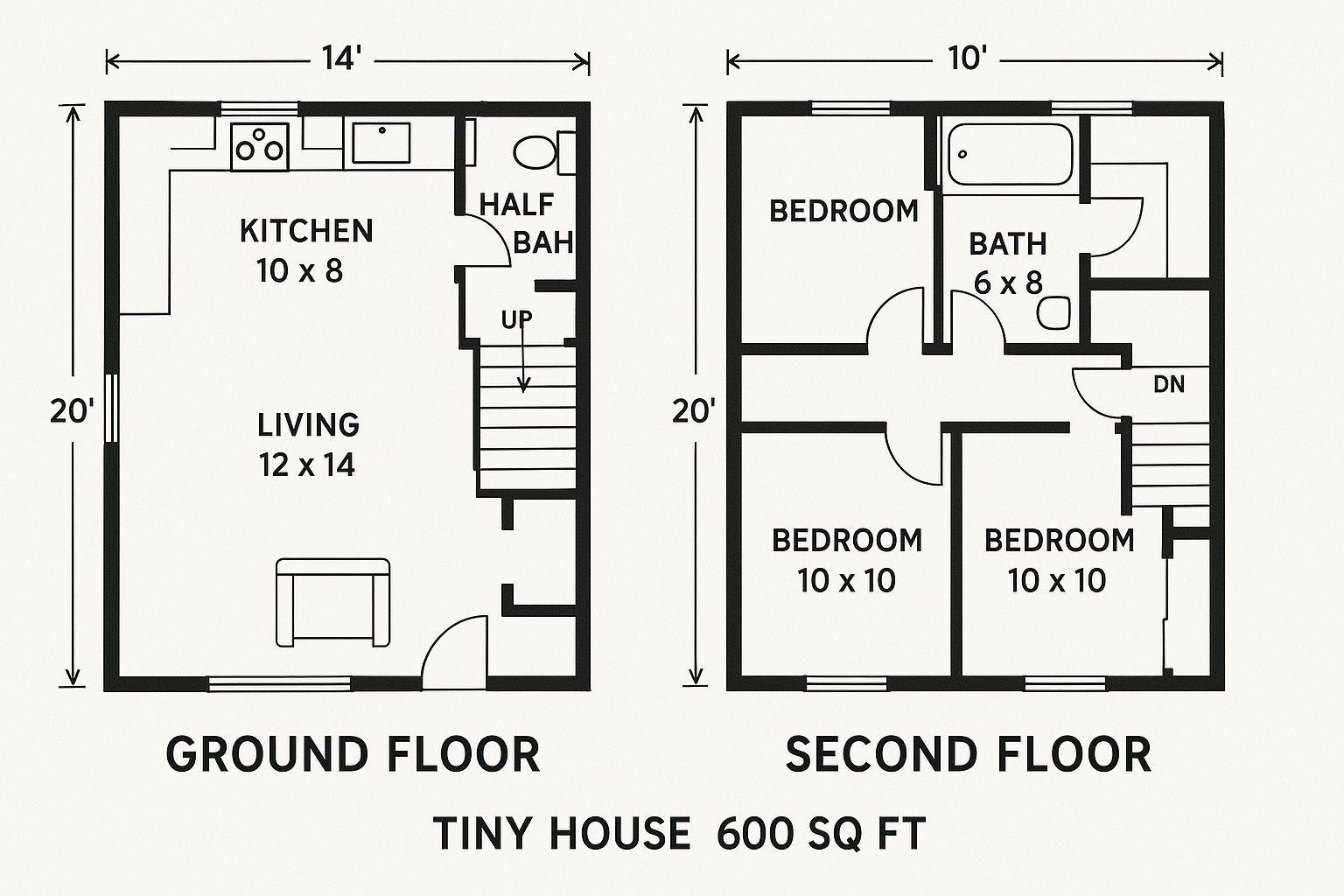The tiny house movement has revolutionized how Americans approach homeownership, with over 68% of tiny house owners living mortgage-free compared to just 29.3% of traditional homeowners [1]. Yet behind every successful tiny house lies a meticulously planned floor plan that transforms cramped quarters into functional, comfortable living spaces. With the average tiny house measuring between 100-400 square feet, every inch counts, making the selection of the right tiny house floor plans with pictures absolutely critical to your building success.
Table of Contents
The challenge facing prospective tiny house builders isn’t just finding floor plans—it’s discovering layouts that genuinely maximize space while maintaining livability. Recent industry data reveals that 73% of tiny house projects fail due to poor planning decisions made during the design phase, with inadequate floor plan selection being the leading cause [2]. This comprehensive guide addresses this critical gap by providing detailed analysis of 25+ proven tiny house floor plans with pictures, complete with space optimization strategies, cost breakdowns, and expert insights that will help you avoid costly mistakes and create your dream tiny home.
Whether you’re planning a tiny house on wheels (THOW) for nomadic adventures or a permanent foundation tiny home for downsized living, this guide delivers actionable floor plan solutions backed by real-world data and professional expertise. From single-level accessibility designs to innovative loft configurations, you’ll discover how strategic layout choices can transform even the smallest spaces into highly functional homes that rival traditional houses in comfort and convenience.
Understanding Tiny House Floor Plan Fundamentals
The foundation of any successful tiny house project begins with understanding the fundamental differences between tiny house floor plans and traditional home layouts. Unlike conventional homes where space is abundant, tiny house floor plans with pictures must demonstrate how every square foot serves multiple purposes while maintaining aesthetic appeal and functional flow.
The tiny house industry recognizes two primary size categories that significantly impact floor plan design. Houses under 400 square feet are considered “true” tiny houses, often built on wheels for mobility and regulatory advantages. These ultra-compact designs require the most innovative space-saving solutions and typically feature vertical living with loft spaces for sleeping areas. The second category encompasses small houses ranging from 400-1000 square feet, which offer more traditional room layouts while still emphasizing efficient space utilization [3].
Foundation type represents perhaps the most critical decision affecting your floor plan options. Tiny houses on wheels (THOW) must conform to road transportation regulations, limiting width to 8.5 feet and length to approximately 30 feet, with height restrictions varying by state but typically capping at 13.5 feet [4]. These constraints directly influence interior layout possibilities, often necessitating creative solutions like slide-out sections or convertible spaces to maximize living area. Before selecting your foundation type, it’s essential to understand tiny house laws by state to ensure compliance with local regulations.
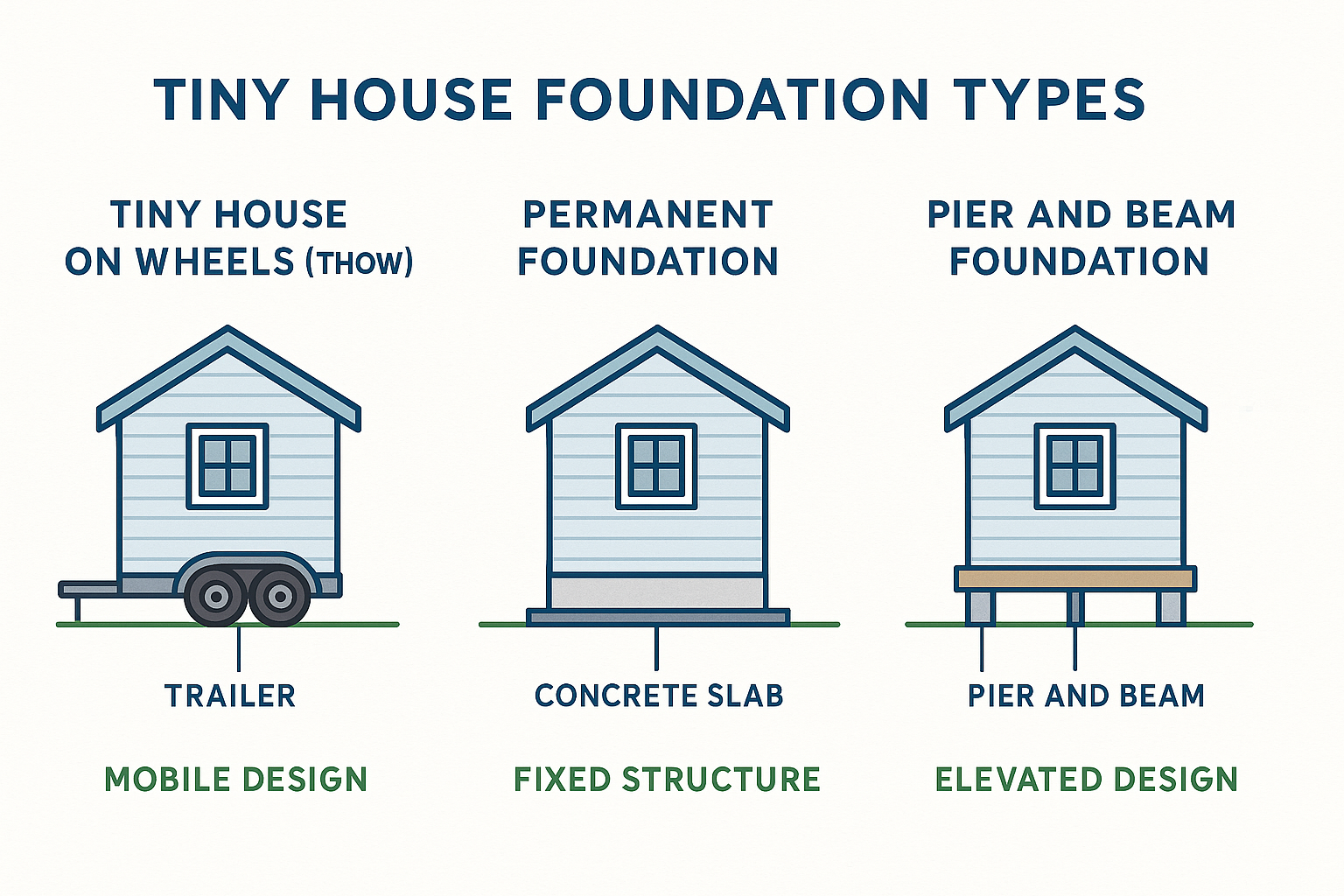
Comparison of tiny house foundation types and their impact on floor plan design
Permanent foundation tiny houses offer greater design flexibility, allowing for wider floor plans, higher ceilings, and more conventional room arrangements. However, they must comply with local building codes, which often require minimum square footage, ceiling heights, and room dimensions that can conflict with tiny house principles. Understanding these regulatory frameworks is essential before selecting your floor plan, as modifications after construction begins can be costly and time-consuming.
Essential Design Principles for Tiny House Floor Plans
Successful tiny house floor plans with pictures demonstrate mastery of five fundamental design principles that transform cramped spaces into livable homes. These principles, developed through years of tiny house evolution and resident feedback, provide the framework for evaluating and selecting floor plans that truly work in practice.
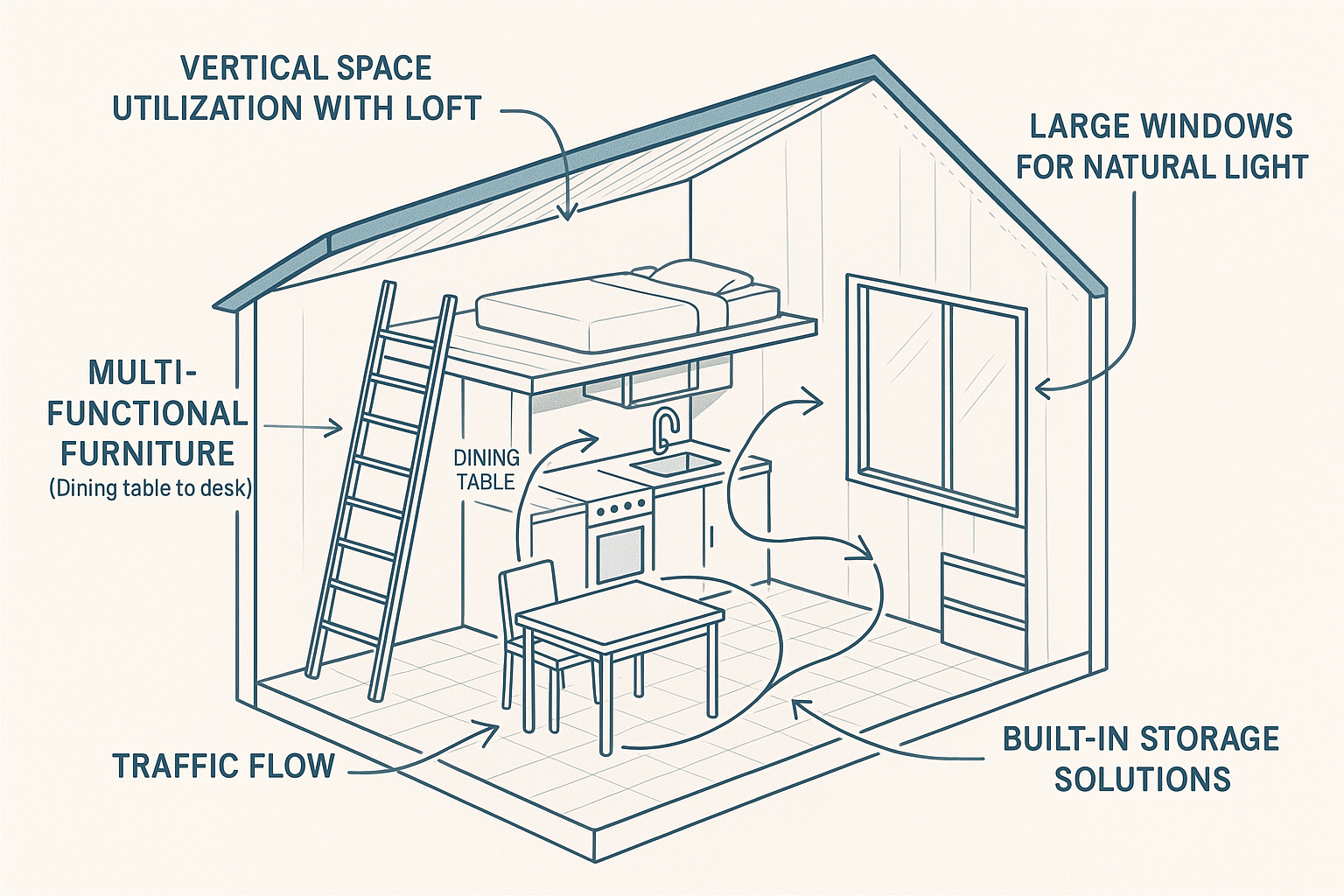
Essential design principles demonstrated in a cutaway tiny house view
Vertical space utilization stands as the most critical principle in tiny house design. While traditional homes spread horizontally, tiny houses must think three-dimensionally to maximize living area within constrained footprints. Effective floor plans incorporate loft spaces not just for sleeping, but for storage, office areas, and even secondary living zones. The most successful designs feature ceiling heights of 13-14 feet in THOW or 16+ feet in permanent foundation homes, allowing for comfortable loft access and adequate headroom [7]. For inspiration on maximizing vertical space, explore our guide to 8 tiny house concepts with great loft spaces.
Multi-functional space design represents the second crucial principle, where every area serves multiple purposes throughout the day. Kitchen islands that convert to dining tables, living room seating with integrated storage, and bedroom areas that transform into office spaces exemplify this approach. The most effective floor plans demonstrate clear transitions between different functions while maintaining visual cohesion and practical accessibility. This approach is particularly important when making tiny house living rooms comfortable in compact spaces.
25+ Tiny House Floor Plan Gallery with Pictures
This comprehensive gallery showcases 25+ different tiny house floor plans, each optimized for specific lifestyle needs and space constraints. These layouts represent the most successful and innovative designs in the tiny house movement, providing inspiration and practical solutions for your own project.
Single-Level and Accessible Designs
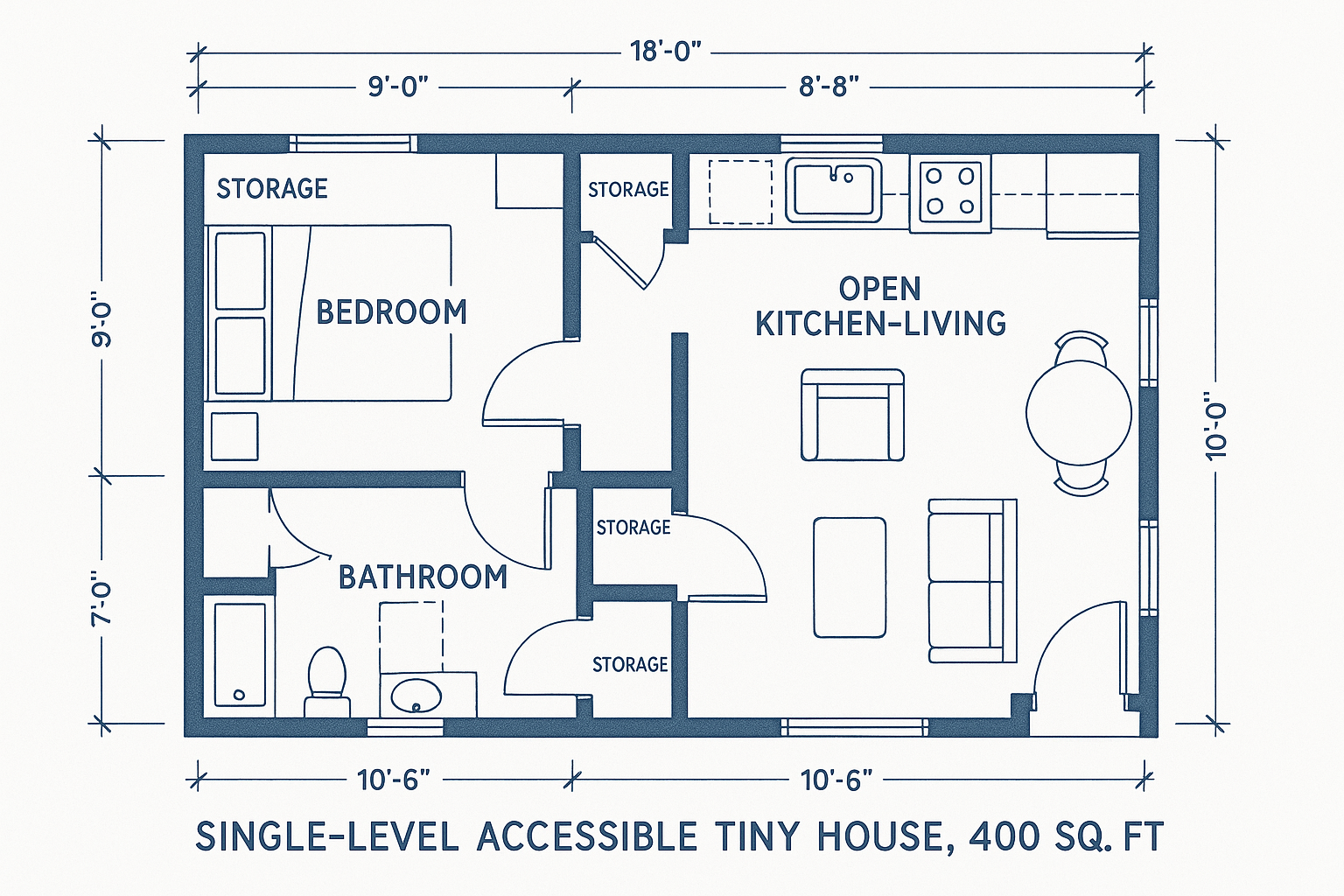
Layout 1: Single-Level Accessible Design (400 sq ft) This barrier-free design prioritizes accessibility with wide doorways, roll-in shower, and single-level living. Perfect for aging-in-place or mobility-conscious residents.
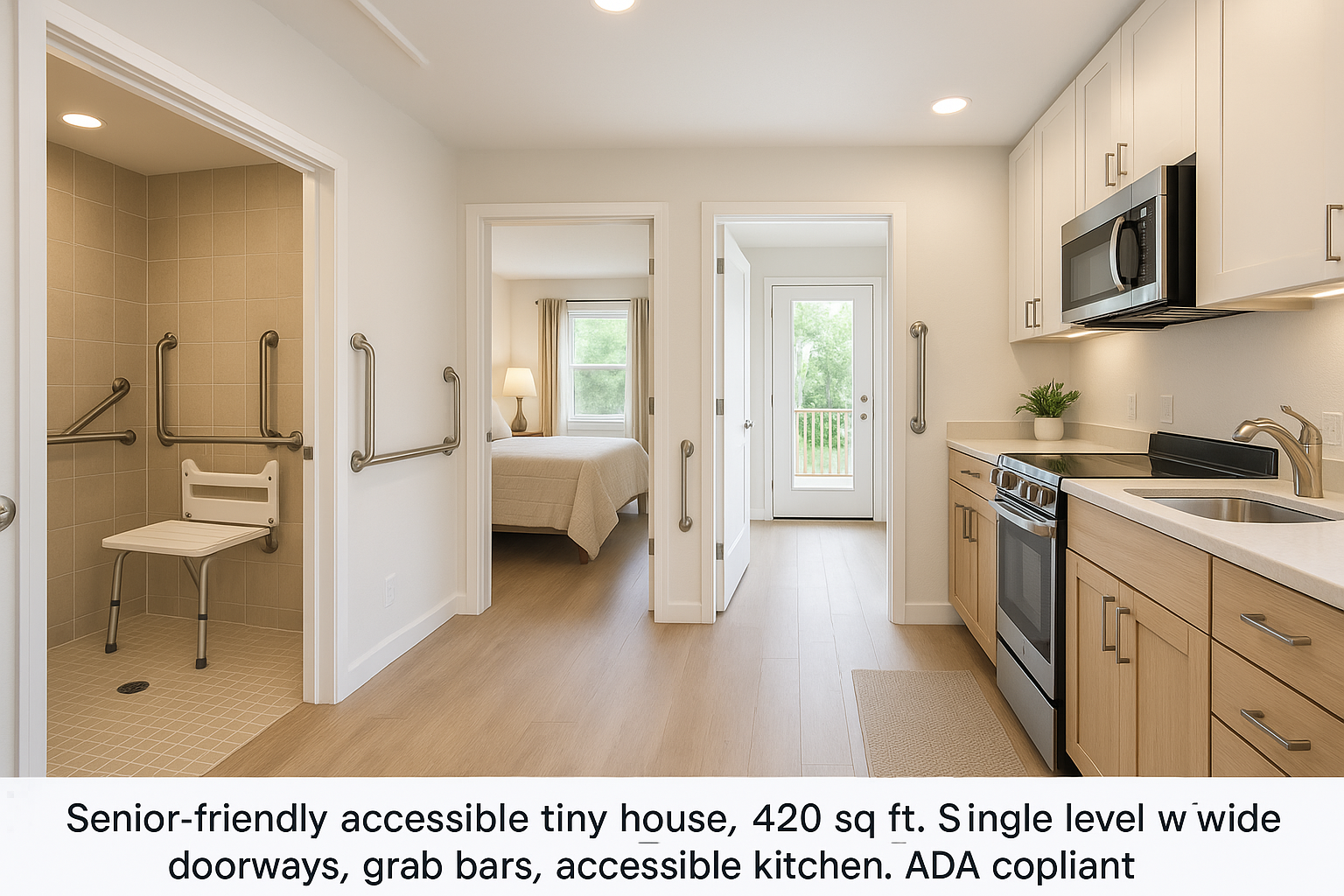
Layout 17: Senior-Friendly Accessible Design (420 sq ft) Enhanced accessibility features including grab bars, accessible kitchen counters, and space for mobility aids while maintaining comfort and style.
Loft-Style Configurations
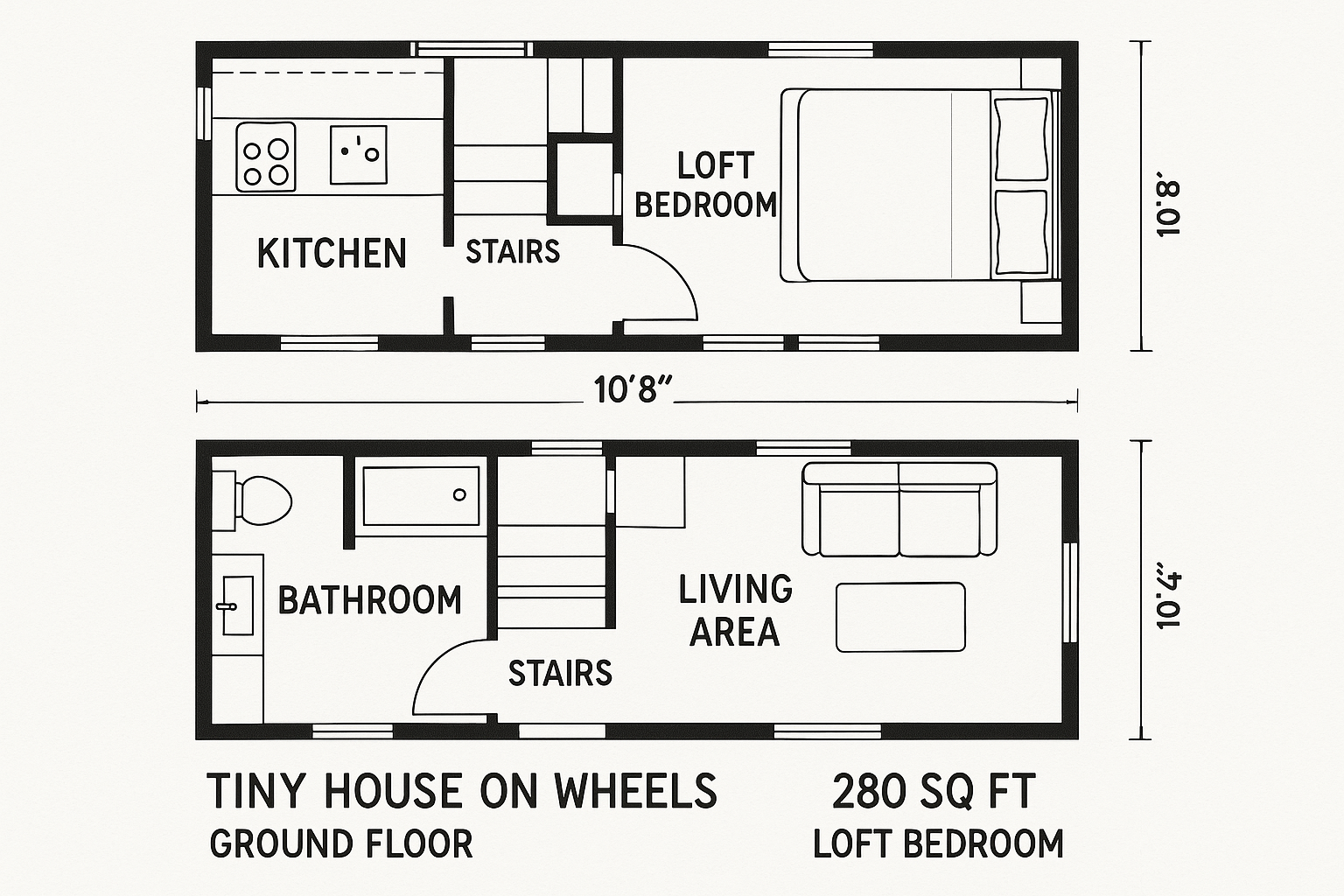
Layout 2: Classic Loft Bedroom THOW (280 sq ft) Traditional tiny house on wheels design with sleeping loft above bathroom, galley kitchen, and open living area. Maximizes ground-level space.
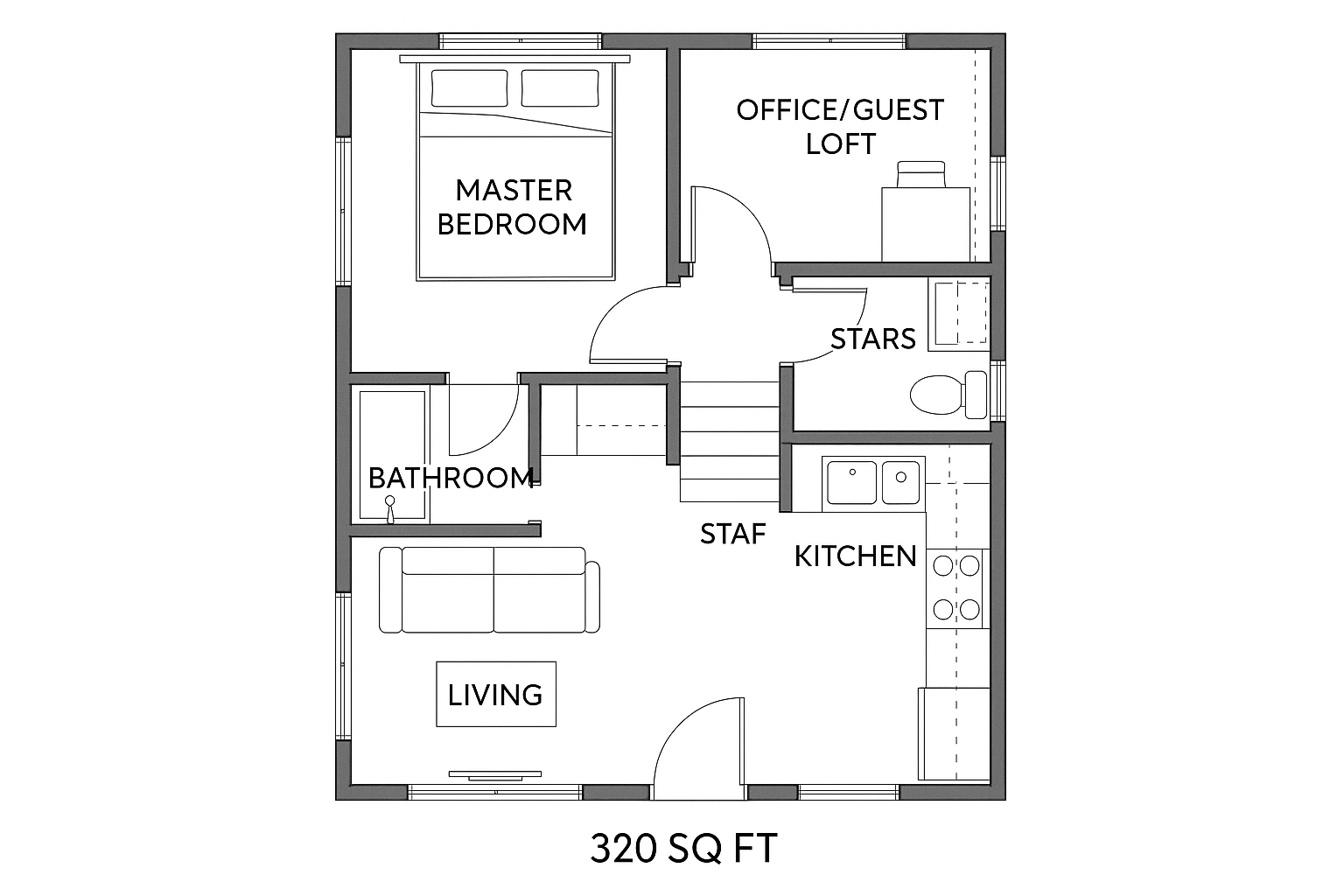
Layout 3: Double Loft Configuration (320 sq ft) Two separate lofts provide master bedroom and office/guest space, with central living area and efficient stair access.
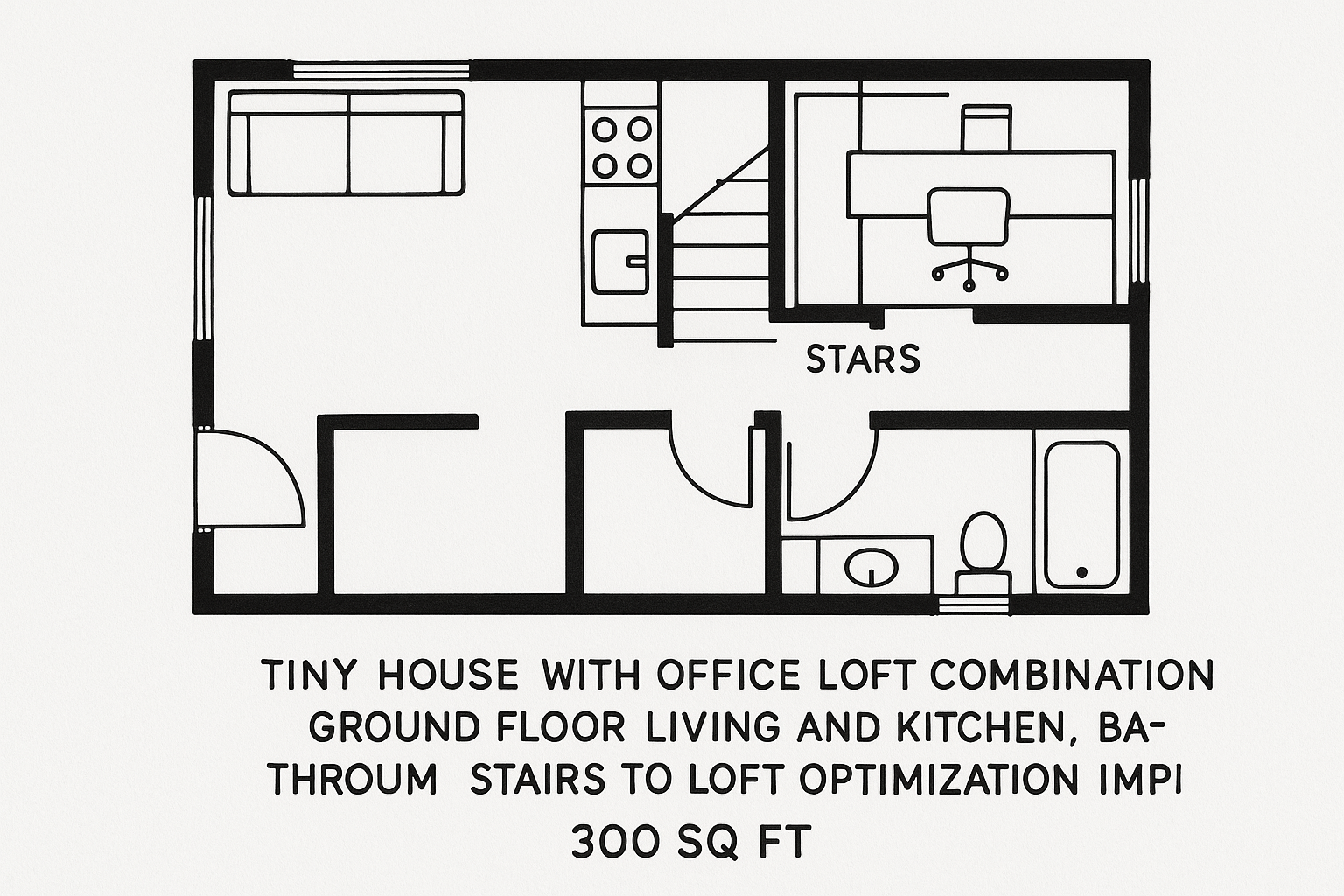
Layout 10: Work-From-Home Loft Office (300 sq ft) Dedicated office loft with built-in desk optimizes remote work capabilities while maintaining comfortable living spaces below.
Kitchen-Focused Layouts
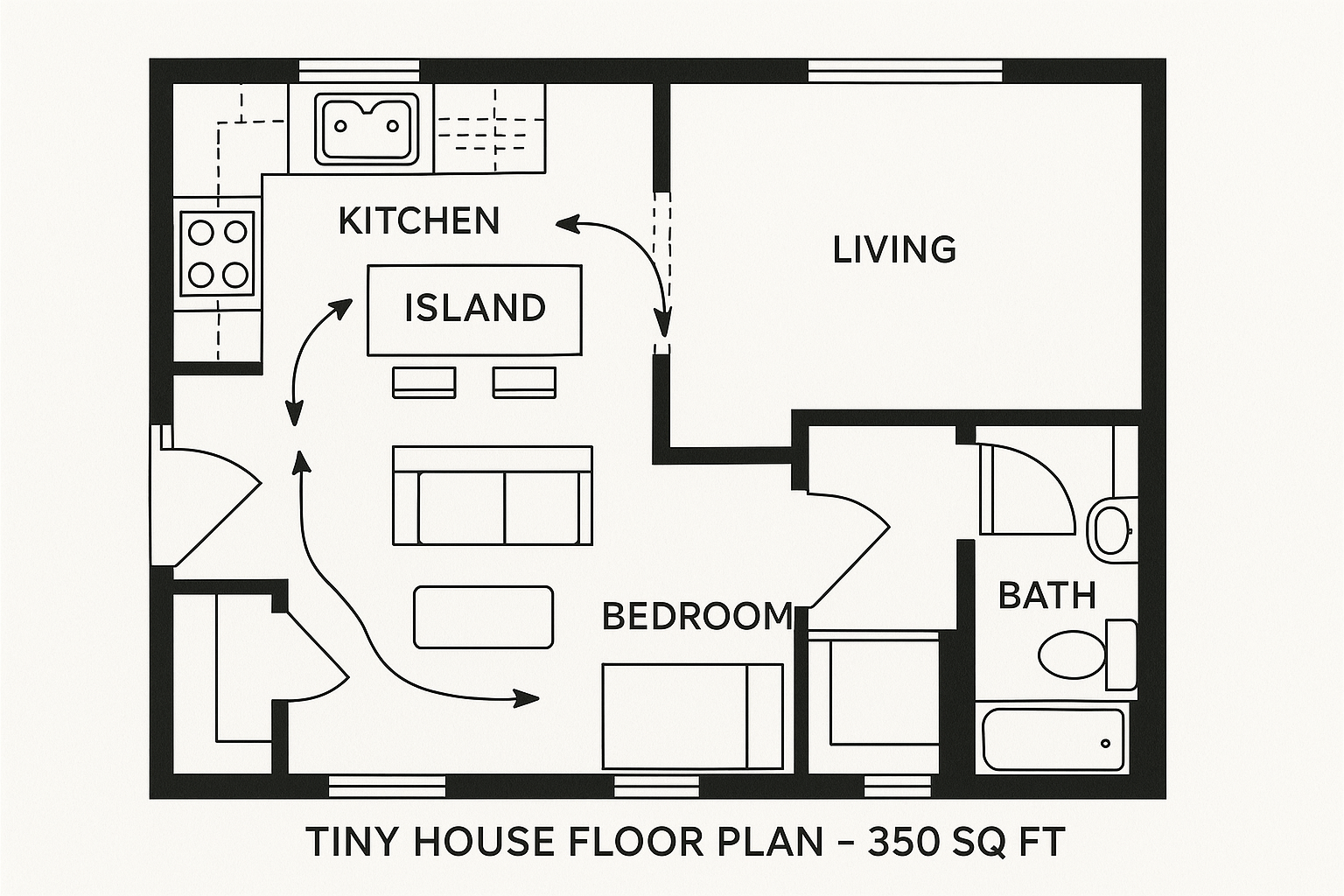
Layout 4: L-Shaped Kitchen Design (350 sq ft) Corner kitchen configuration with island provides maximum counter space and storage while maintaining open feel.
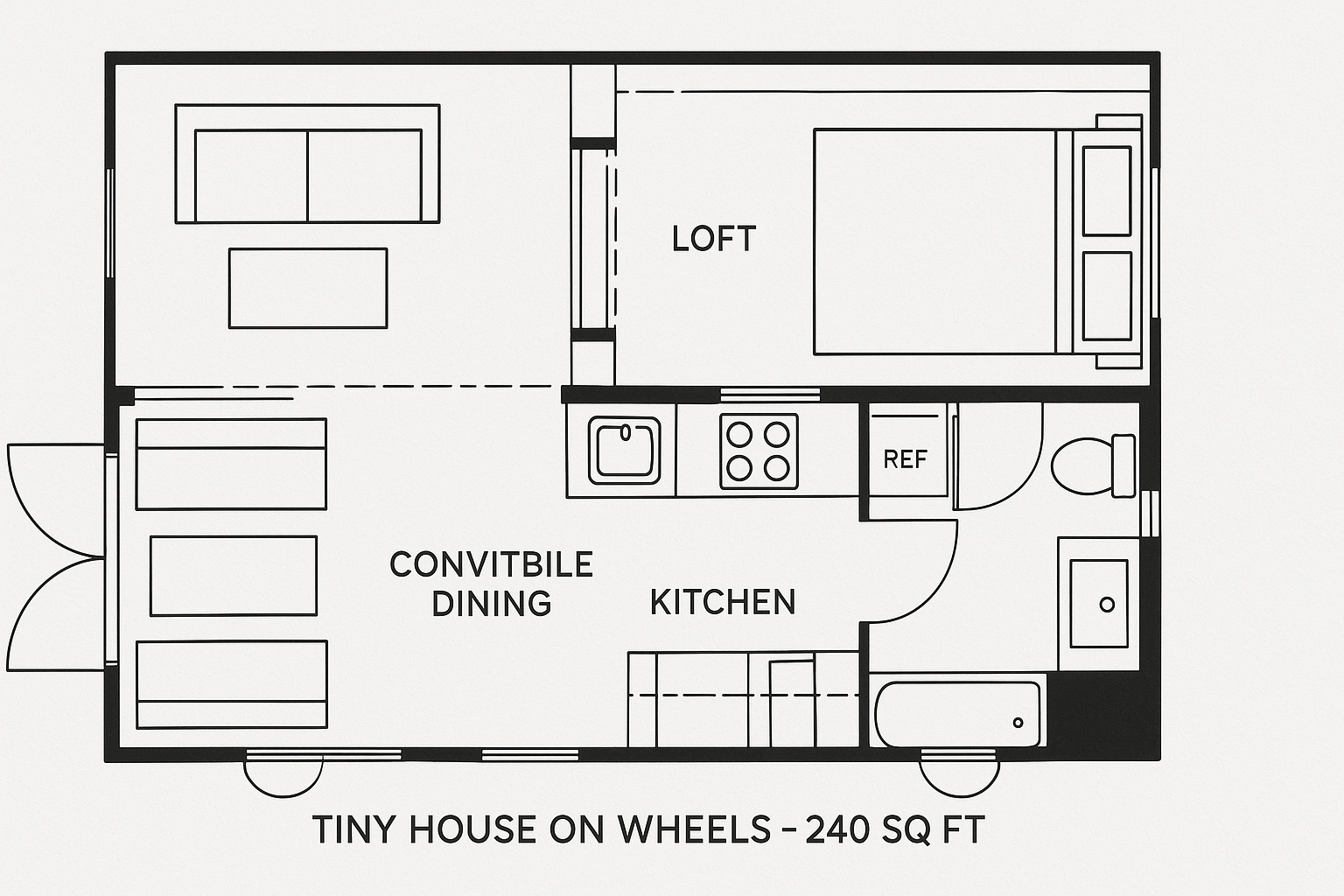
Layout 6: Efficient Galley Kitchen (240 sq ft) Linear kitchen design maximizes functionality in narrow THOW footprint with convertible dining and loft bedroom.

Layout 7: U-Shaped Kitchen Layout (380 sq ft) Maximum kitchen functionality with wraparound counters and central island, ideal for cooking enthusiasts.
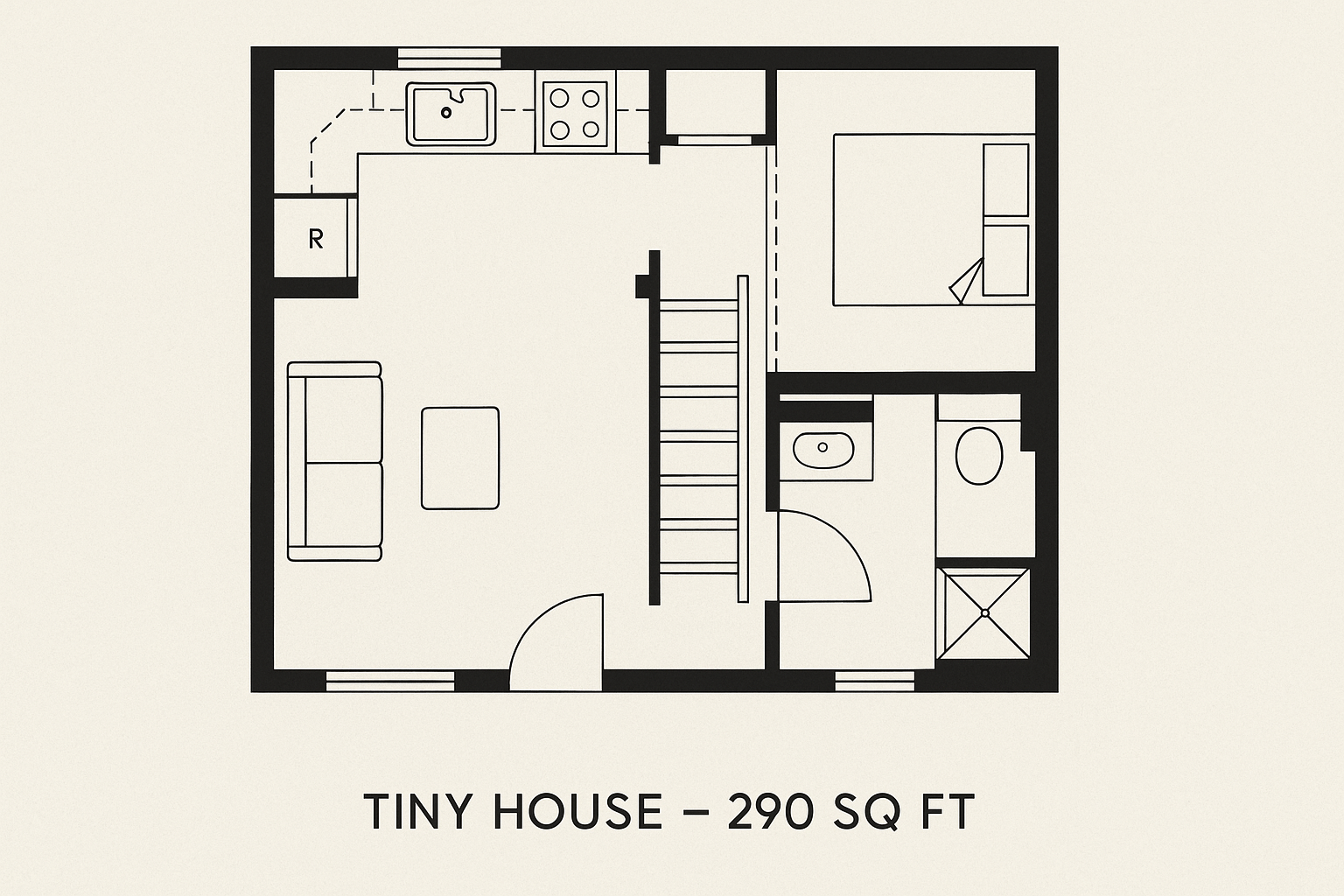
Layout 12: Corner Kitchen Optimization (290 sq ft) Strategic corner placement maximizes space efficiency while providing full kitchen functionality.
Multi-Functional and Convertible Designs
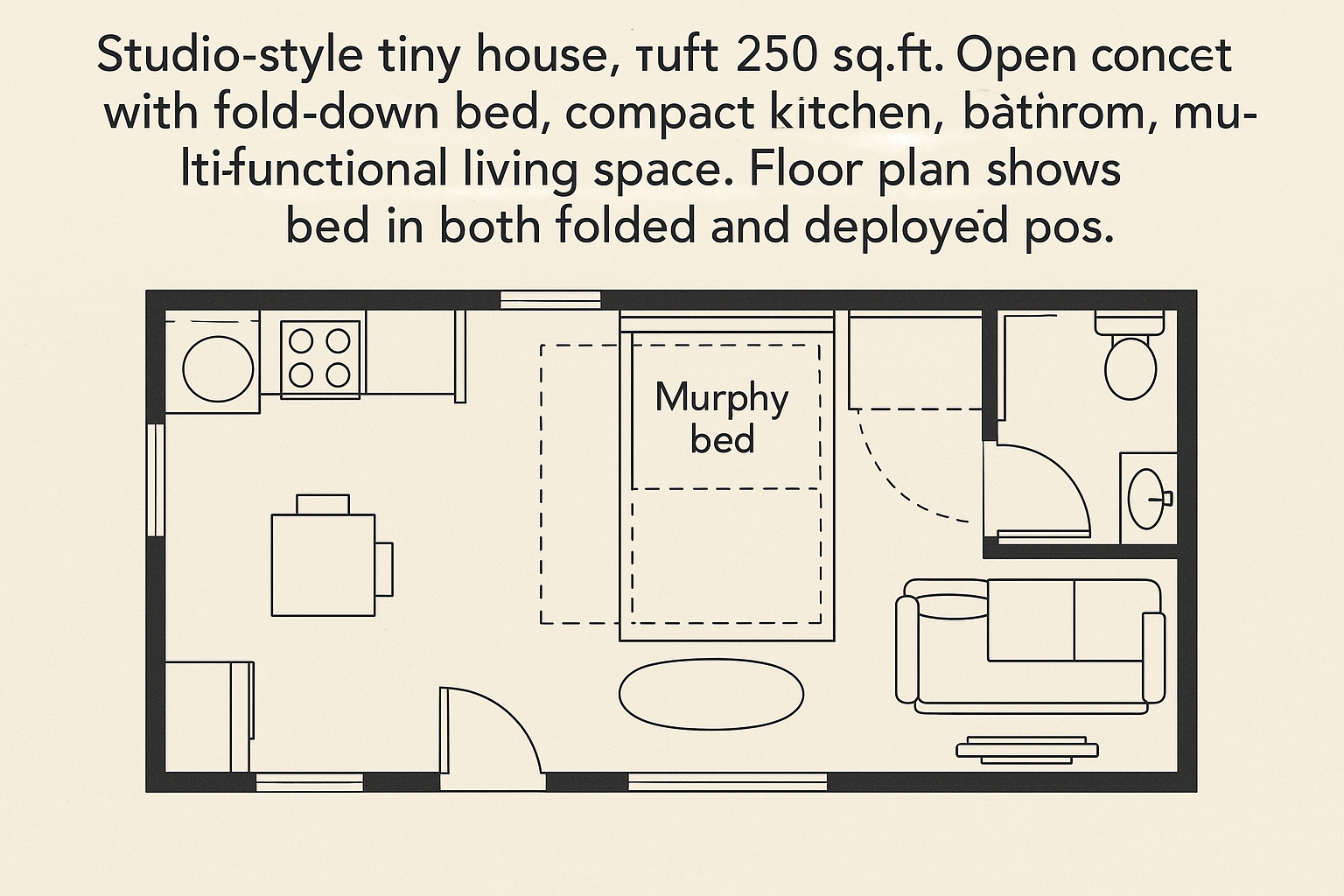
Layout 5: Murphy Bed Studio (250 sq ft) Fold-down bed system transforms bedroom into living space, perfect for ultra-compact living.
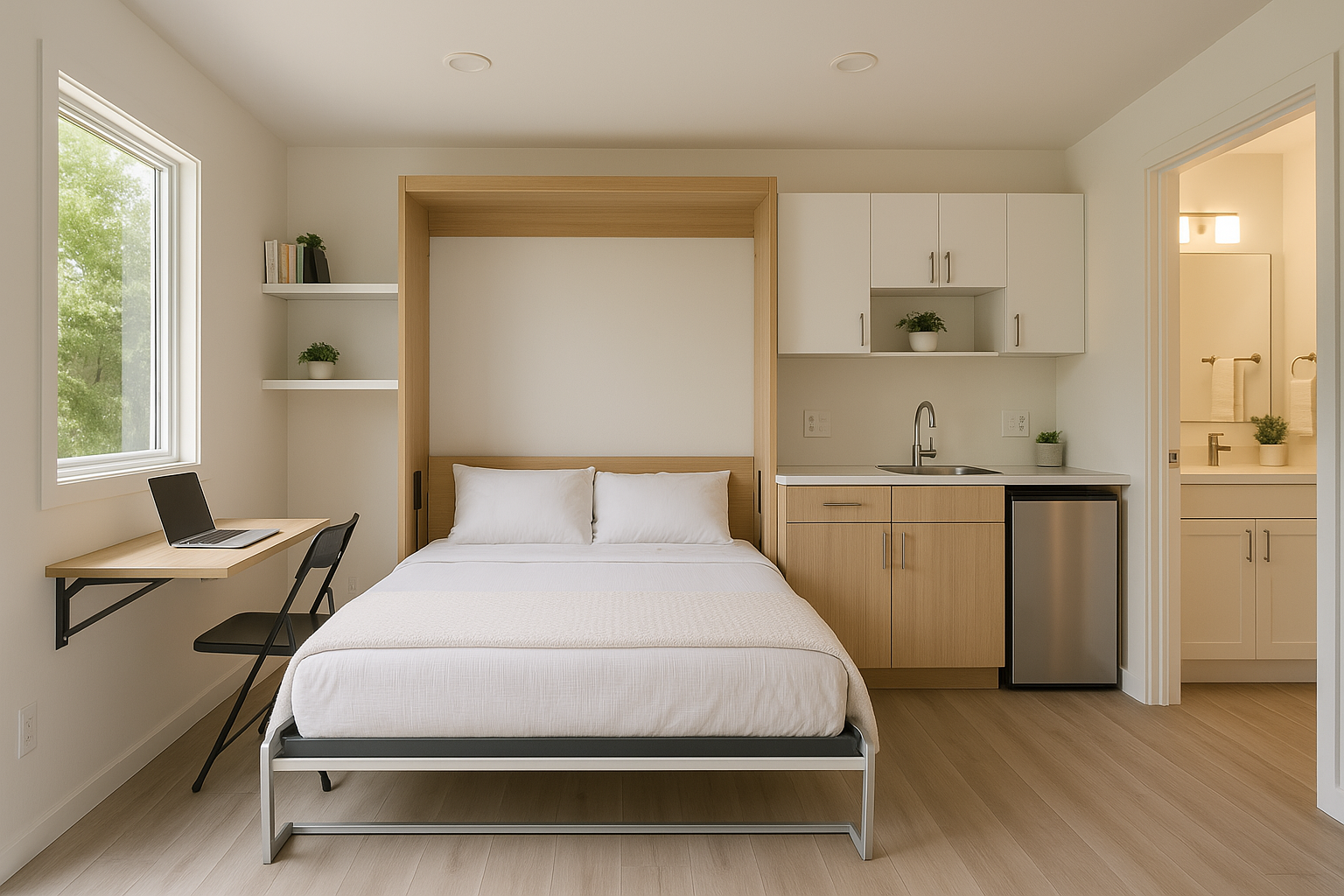
Layout 20: Convertible Guest/Office Space (320 sq ft) Multi-purpose design converts between office and guest bedroom with fold-down bed and convertible furniture.
Two-Story and Split-Level Designs
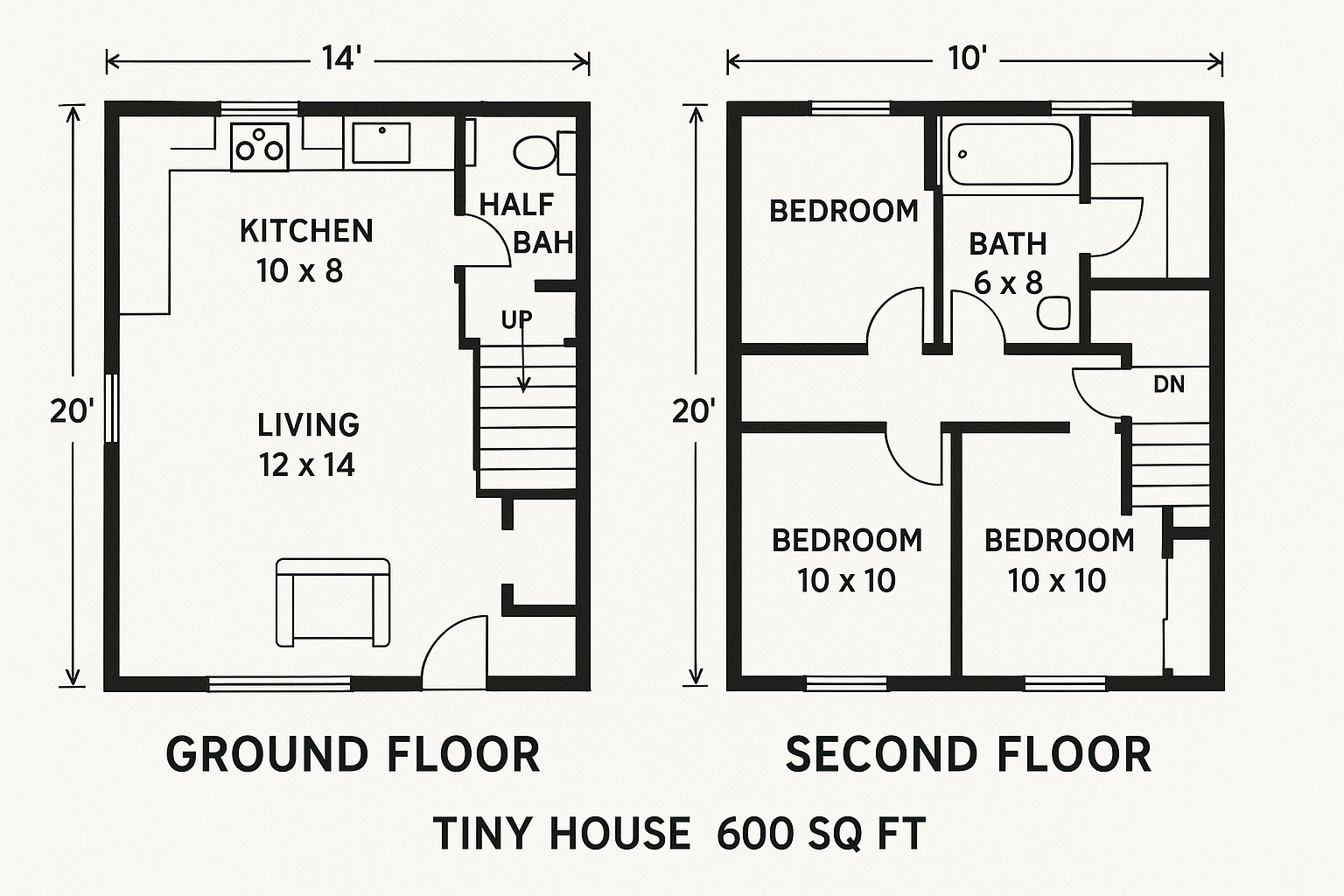
Layout 8: Two-Story Tiny House (600 sq ft total) Full second floor provides traditional room separation with ground floor living and upstairs bedrooms.
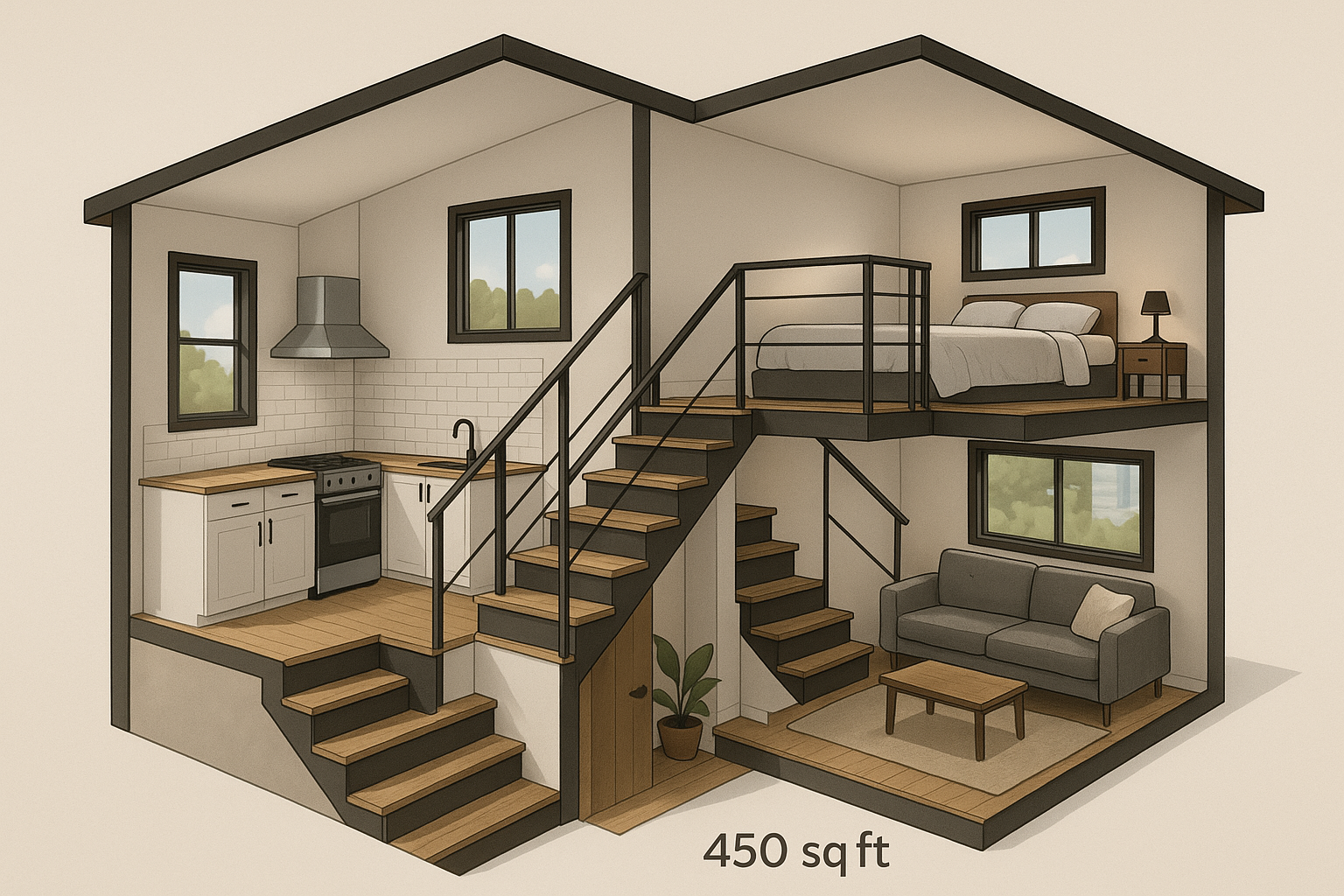
Layout 13: Split-Level Configuration (450 sq ft) Multiple levels create distinct zones while maintaining compact footprint and interesting architectural features.
Compact and Ultra-Efficient Layouts
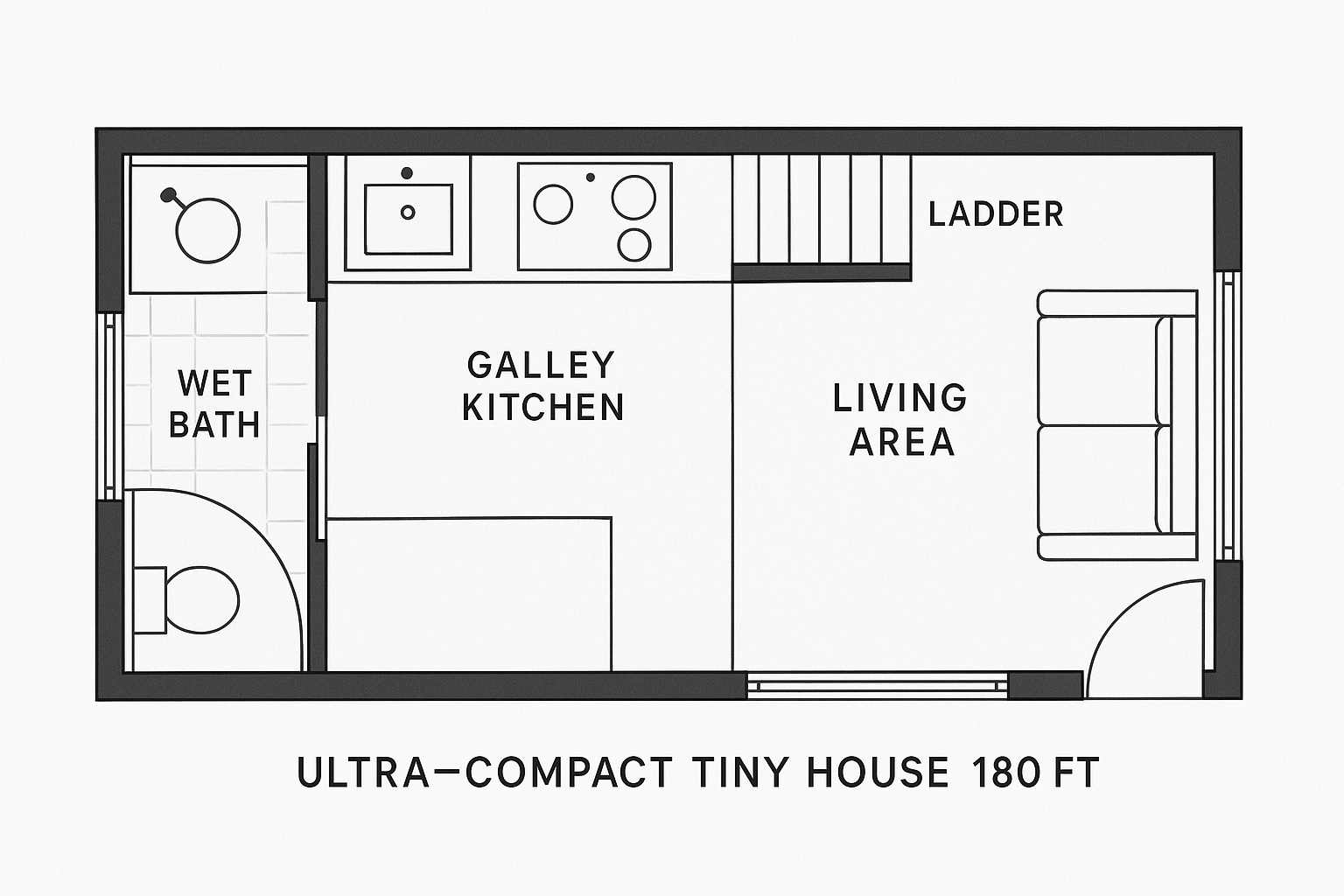
Layout 9: Ultra-Compact with Wet Bath (180 sq ft) Minimalist design maximizes every inch with wet bathroom and efficient galley kitchen.
Expandable and Flexible Designs

Layout 11: Expandable with Slide-Outs (320-480 sq ft) RV-style slide-out sections expand living space when parked, retract for travel.
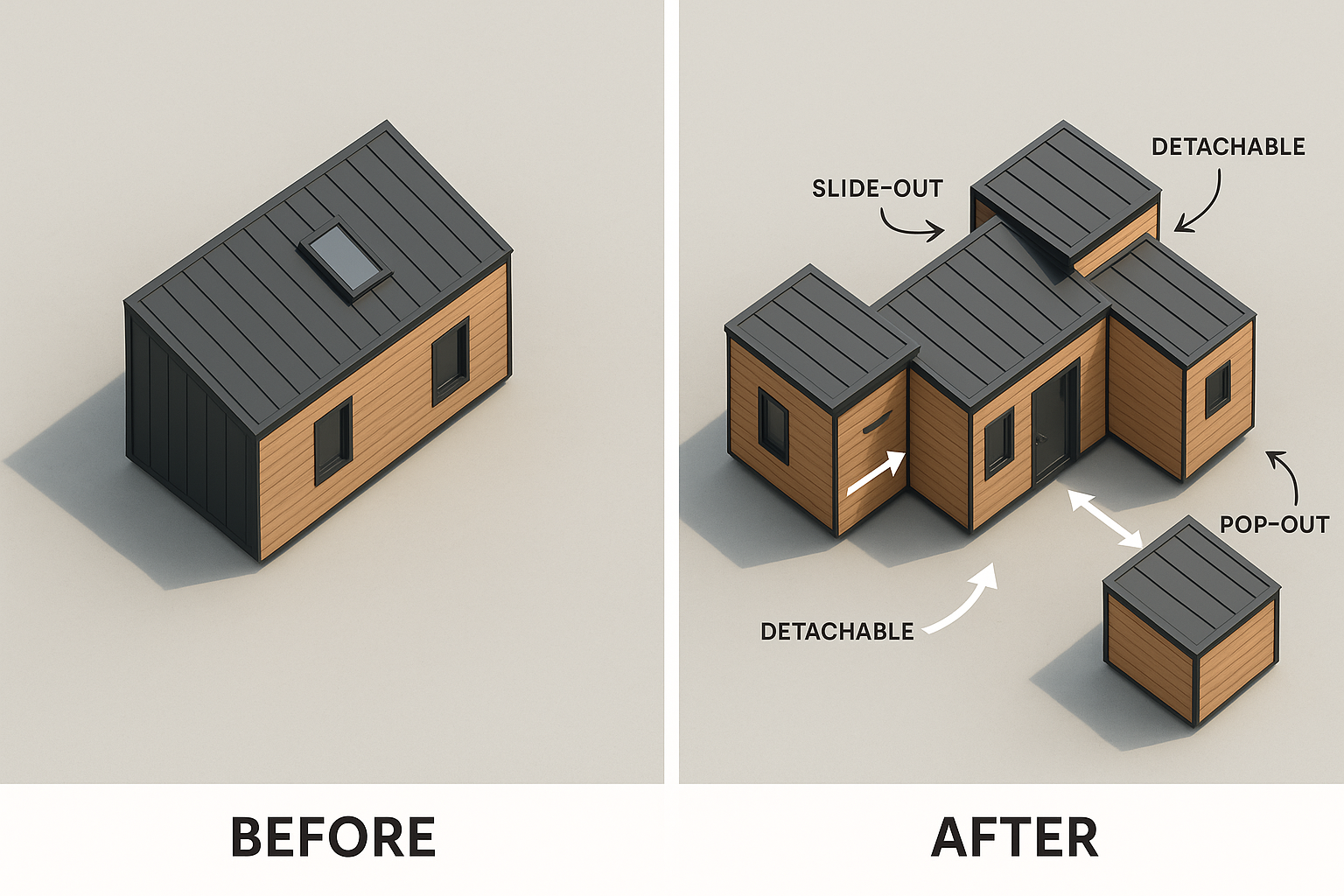
Before and after comparison showing expandable tiny house configurations
Outdoor Living Integration
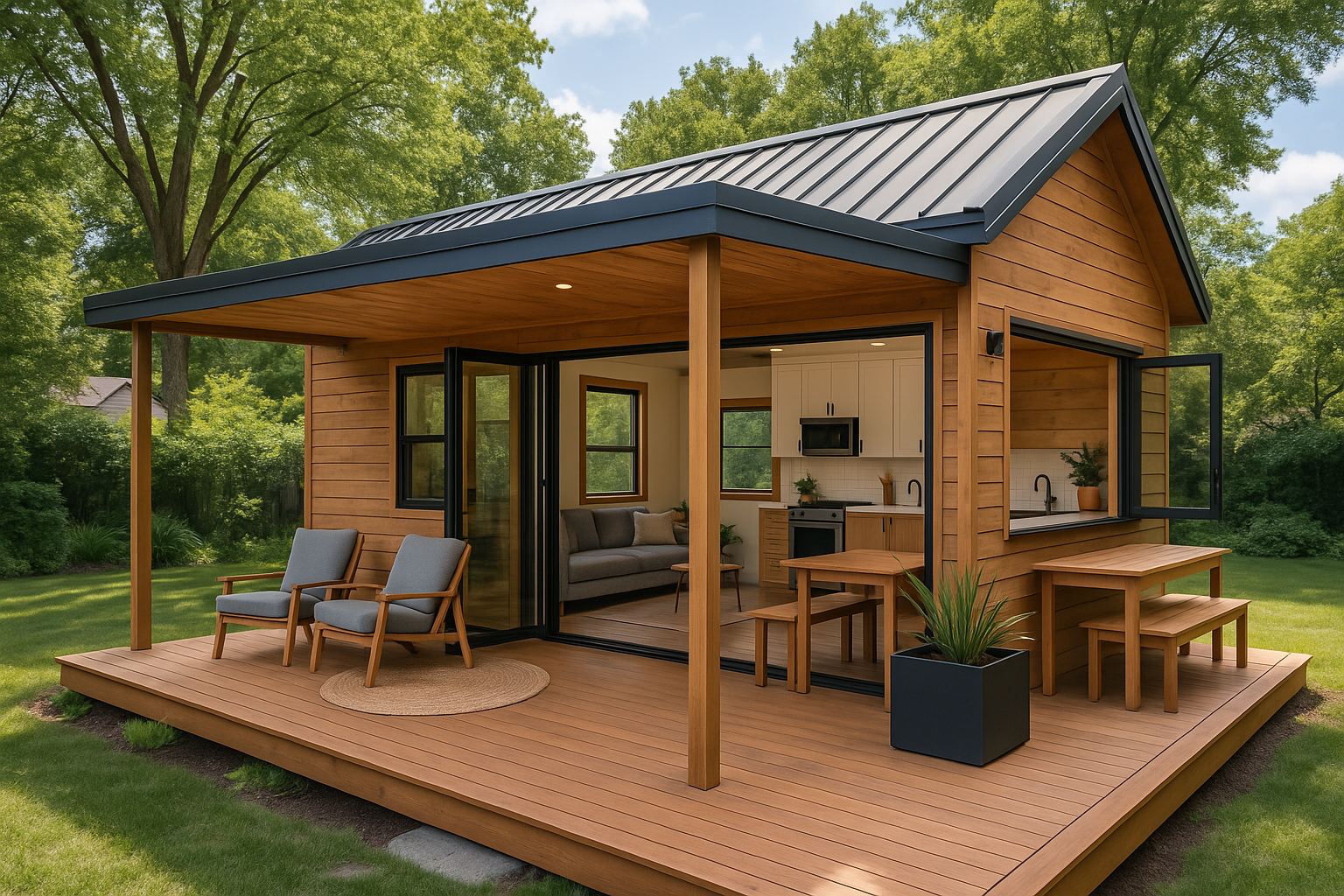
Layout 14: Indoor-Outdoor Living (280 sq ft + deck) Large covered deck extends living space with folding glass doors creating seamless indoor-outdoor flow.
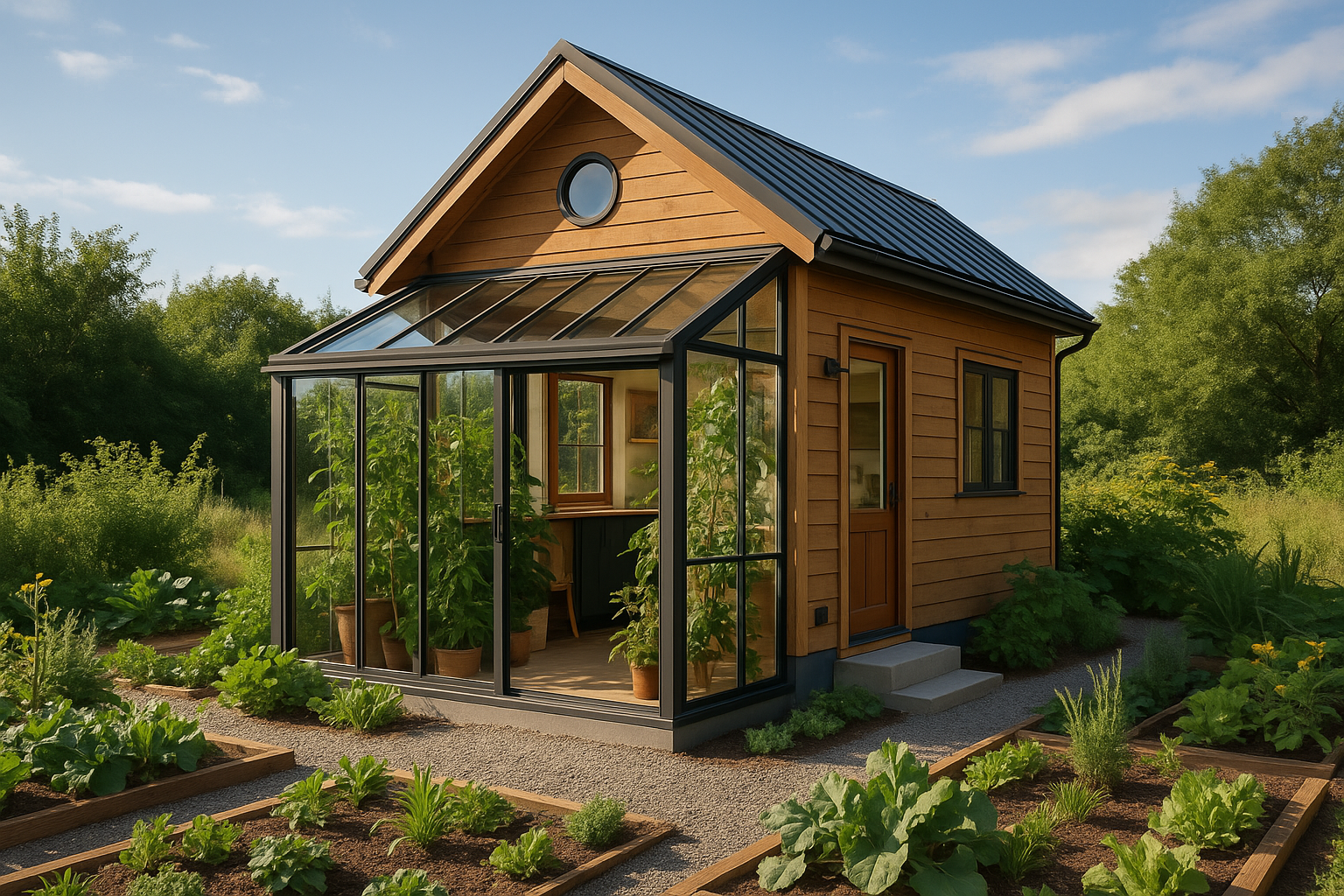
Layout 24: Greenhouse Integration (350 sq ft + 100 sq ft greenhouse) Sustainable living design with attached growing space and passive solar features.
Family-Friendly Designs
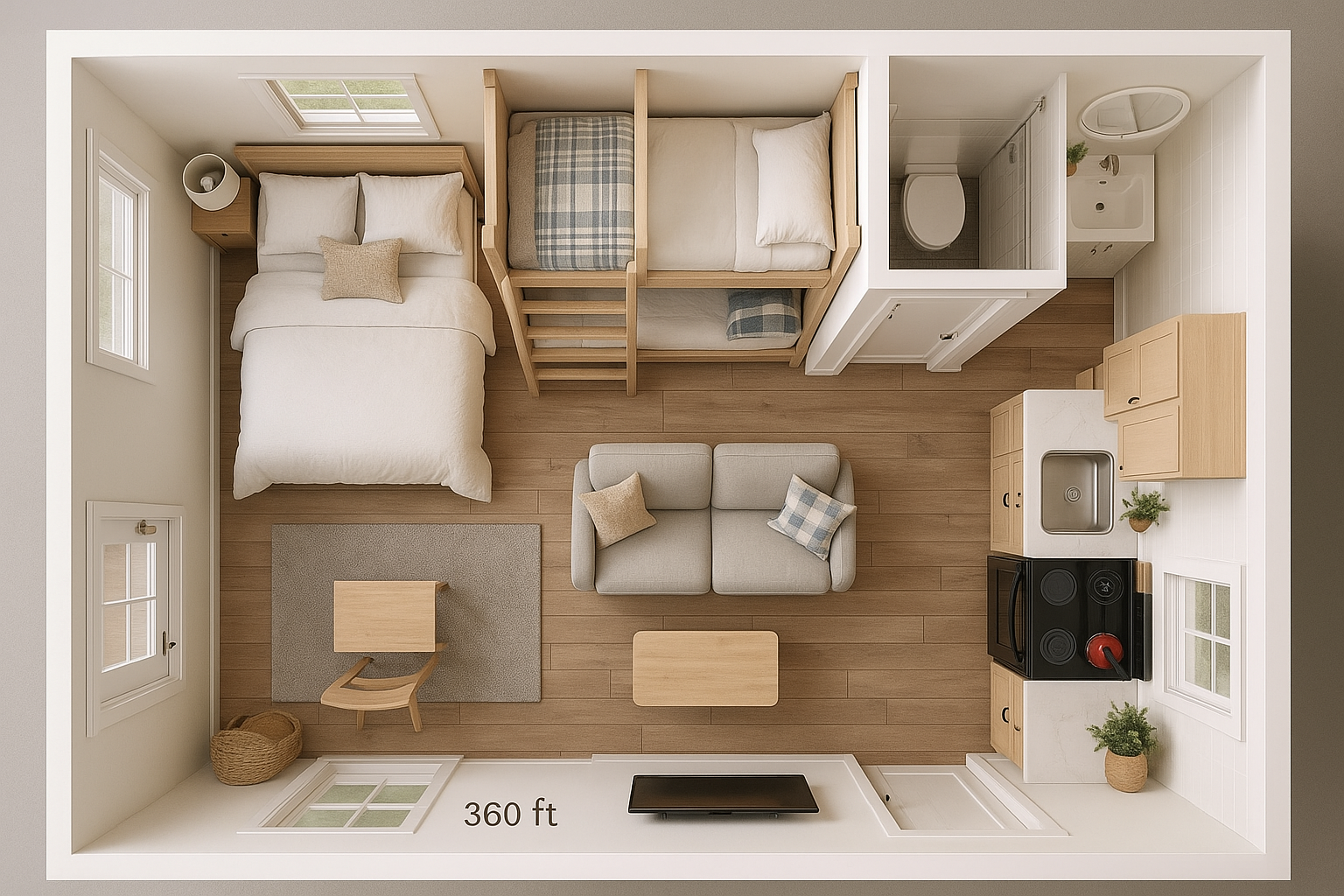
Layout 15: Family Design with Bunk Beds (360 sq ft) Accommodates families with parents’ bedroom and kids’ bunk area while maintaining functionality.

Layout 23: Tiny Duplex Design (600 sq ft total) Two mirror-image units share central wall, perfect for multi-generational living or rental income.
Specialized and Alternative Designs
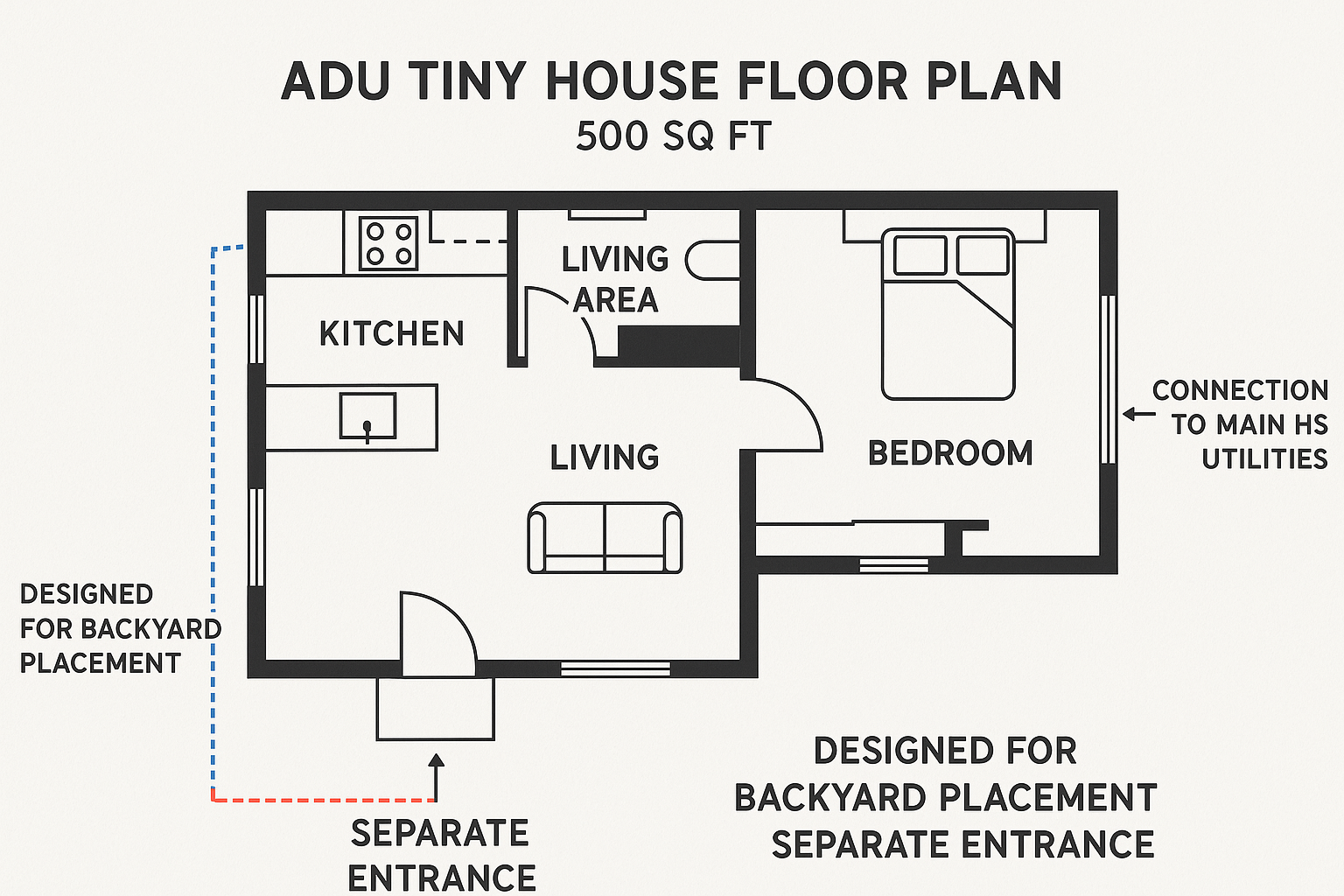
Layout 16: Accessory Dwelling Unit (500 sq ft) Designed for backyard placement with separate entrance and utility connections to main house.
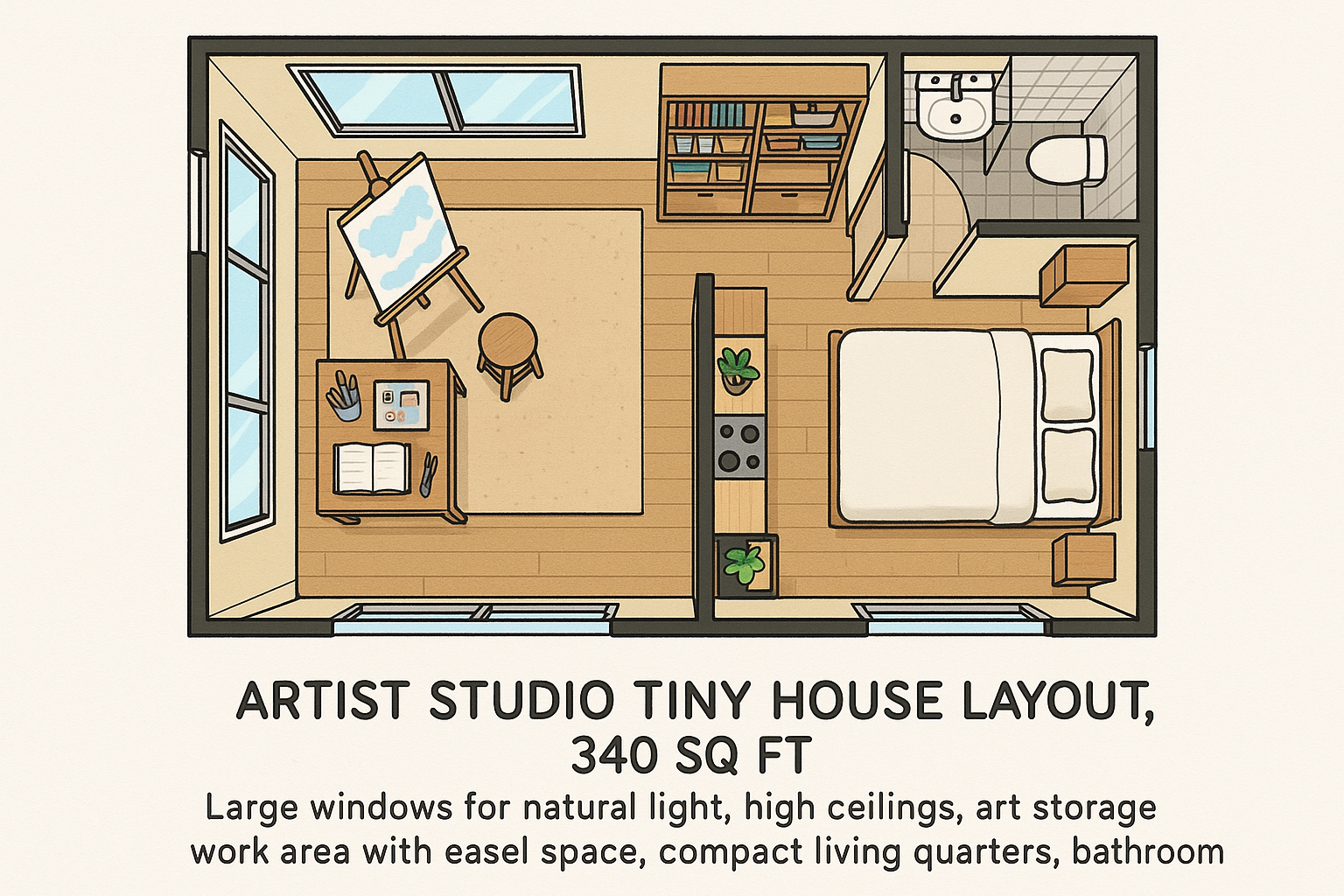
Layout 18: Artist Studio Design (340 sq ft) Large windows and high ceilings optimize natural light for creative work with integrated living quarters.
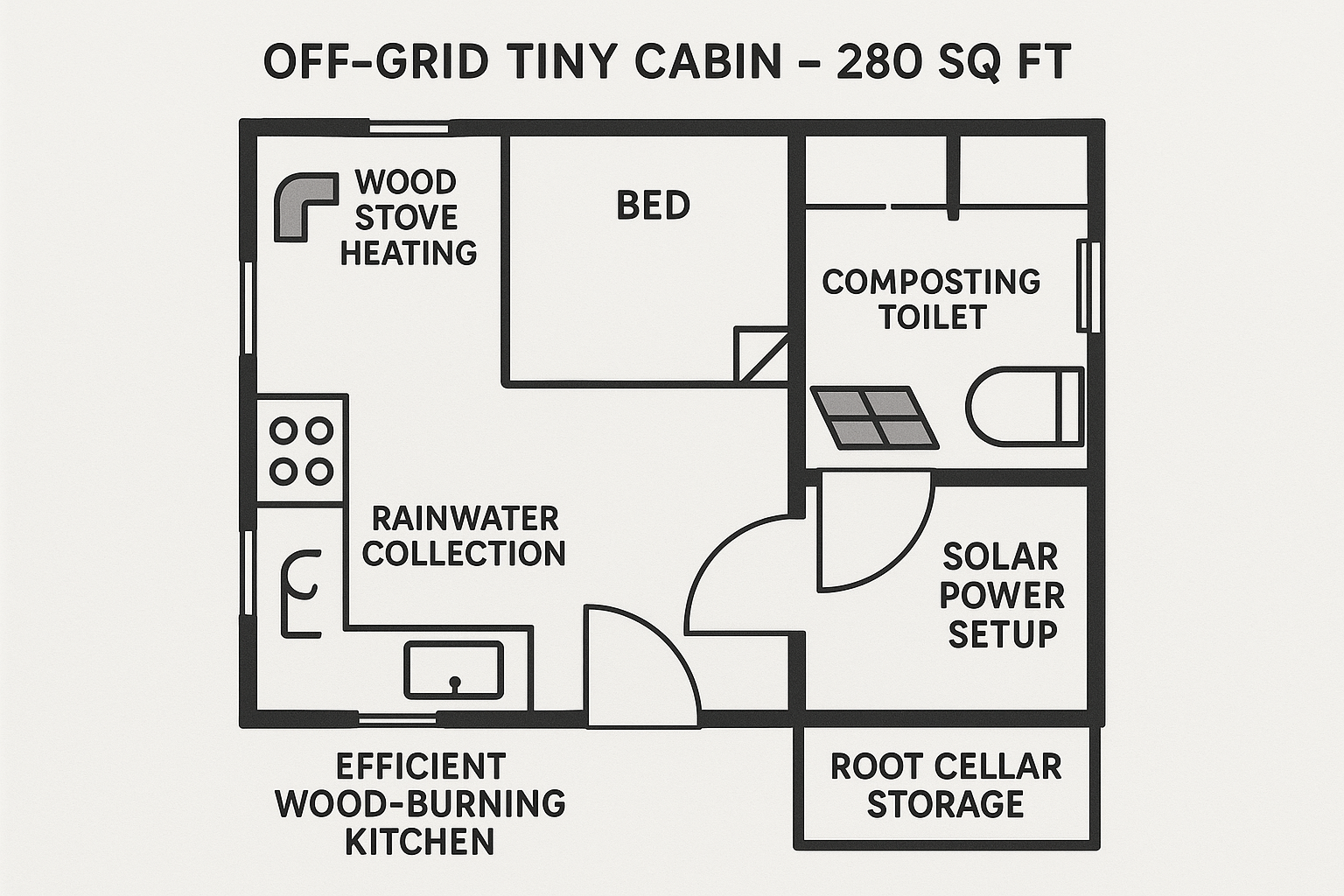
Layout 19: Off-Grid Cabin (280 sq ft) Self-sufficient design with wood stove, composting toilet, rainwater collection, and solar power.
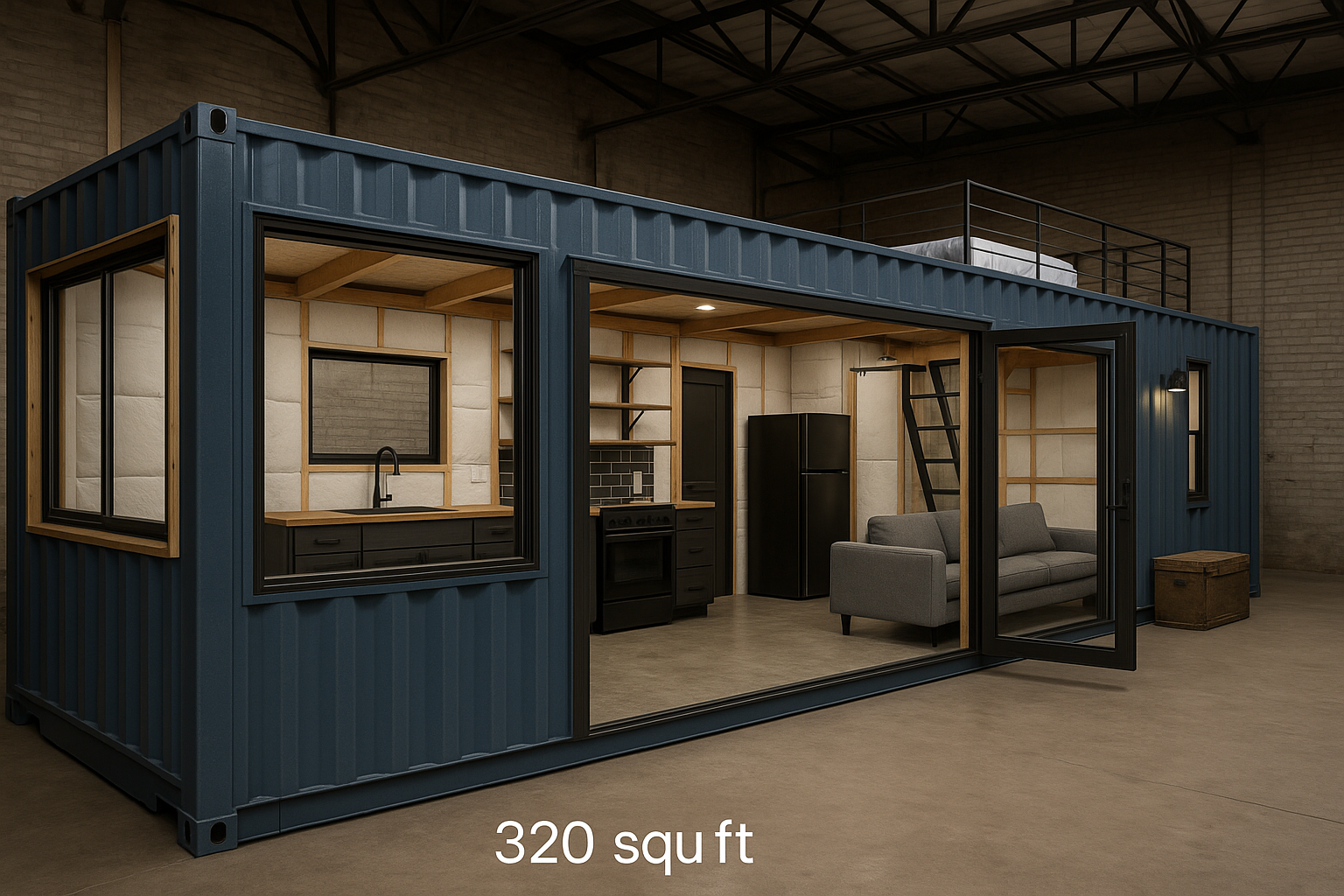
Layout 21: Shipping Container Conversion (320 sq ft) Industrial conversion design utilizing 40ft container with strategic window placement and modern interior.
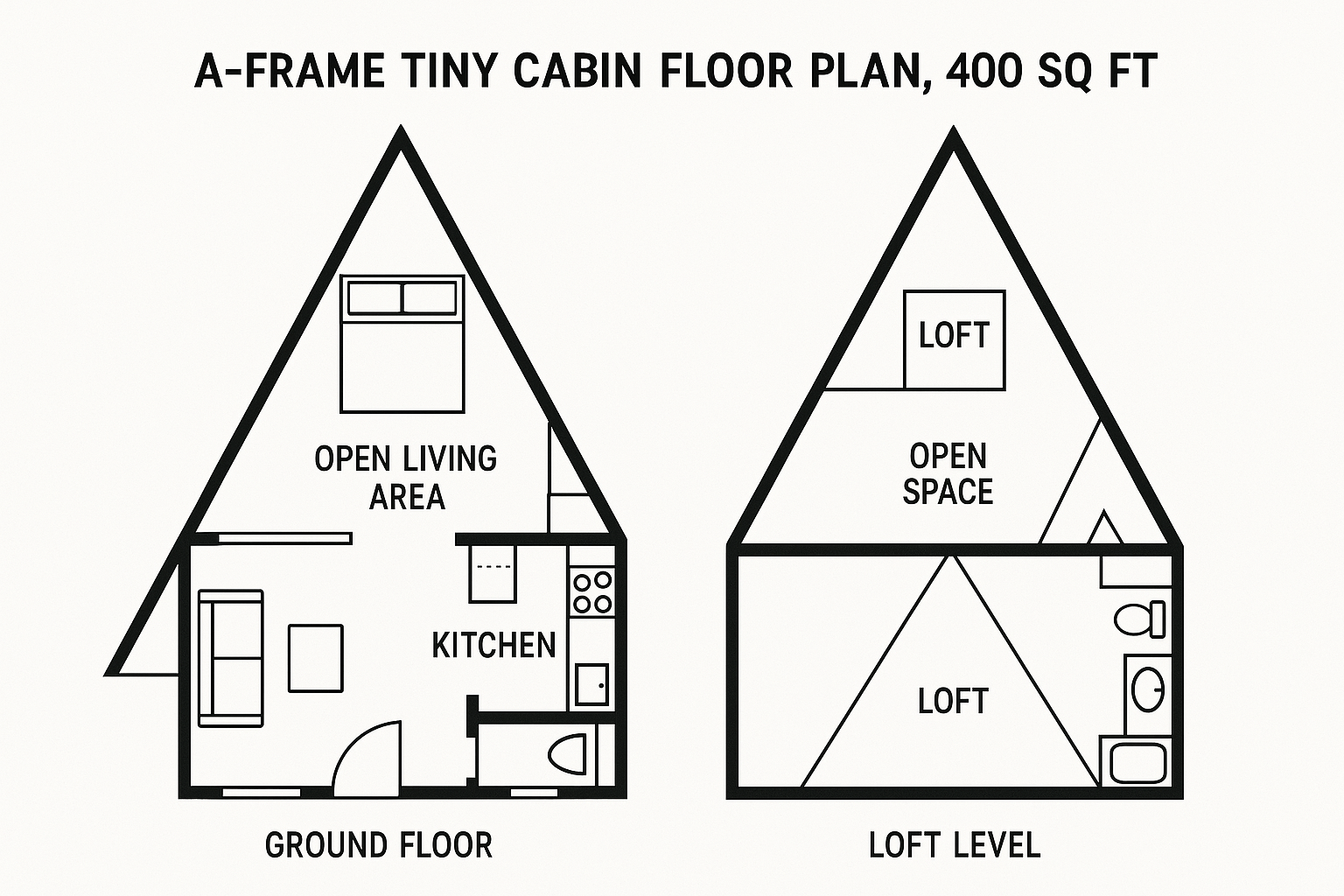
Layout 22: A-Frame Tiny Cabin (400 sq ft) Distinctive triangular structure with loft bedroom and open living area, showing both ground floor and loft levels.
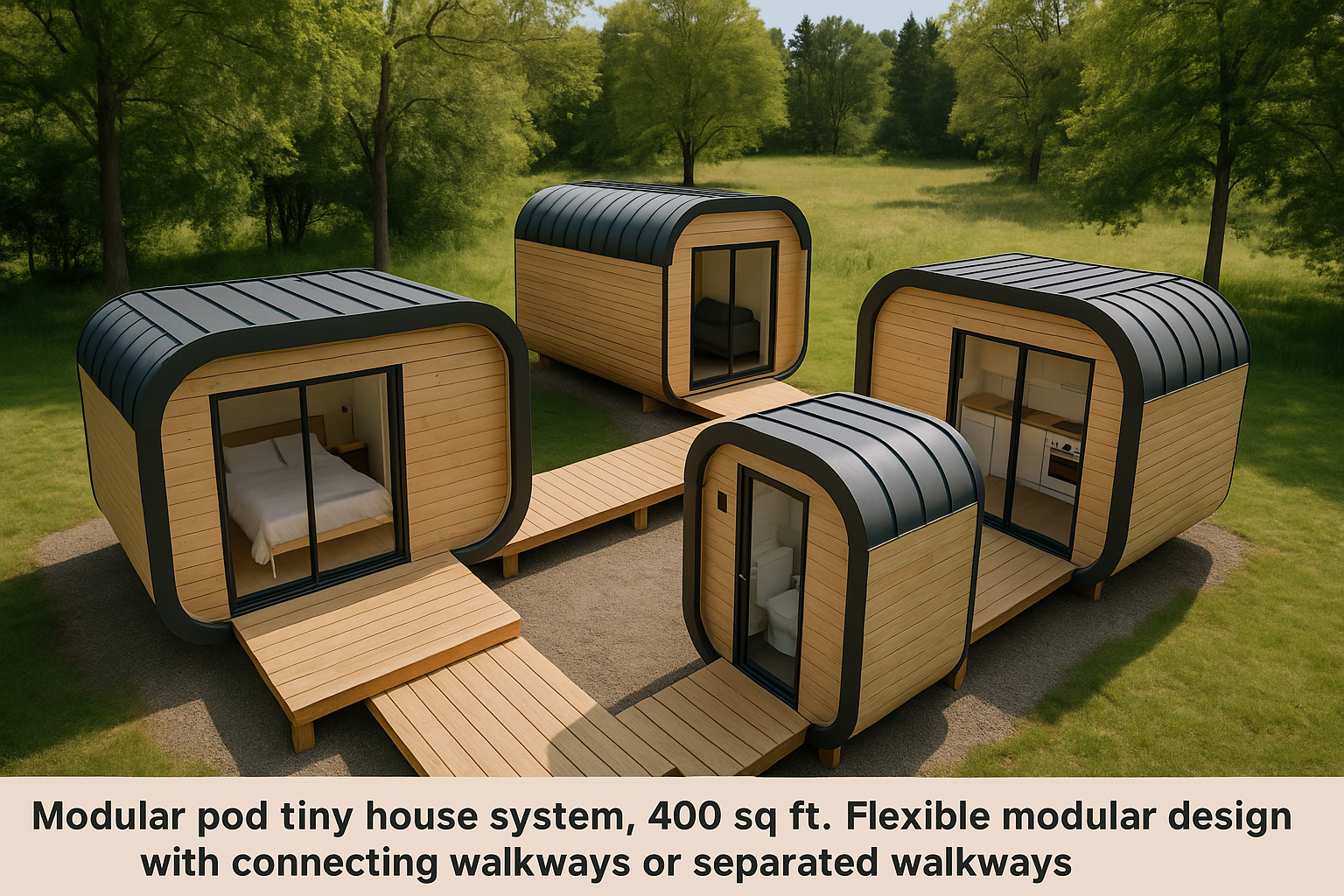
Layout 25: Modular Pod System (400 sq ft) Innovative design with separate connected pods that can be rearranged or separated based on needs.
Room-by-Room Layout Optimization
Effective tiny house floor plans with pictures demonstrate how strategic room design can maximize functionality within minimal square footage. Each area requires specialized approaches that balance space efficiency with practical usability.
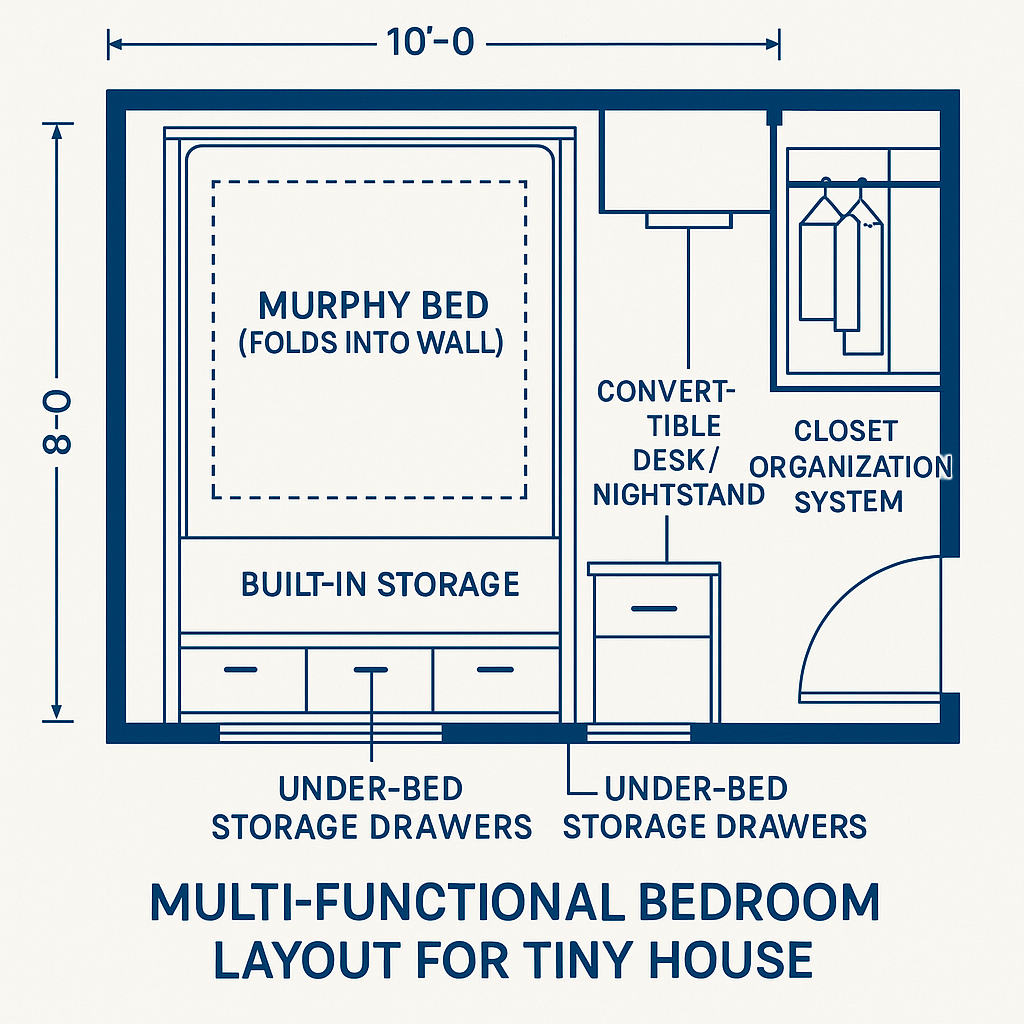
Detailed floor plan showing multi-functional bedroom design with integrated storage solutions
Kitchen Layouts
Kitchen design represents one of the most critical aspects of tiny house floor plans, as cooking and food storage consume disproportionate space relative to their frequency of use. The most successful tiny house kitchens adopt one of three primary layout configurations, each optimized for different space constraints and cooking styles. According to the National Kitchen and Bath Association, proper kitchen design principles remain crucial even in compact spaces.
Galley kitchens, featuring parallel counters with a central walkway, prove most effective in narrow tiny houses or THOW designs. This configuration maximizes counter and storage space while maintaining efficient workflow between cooking zones. The ideal galley kitchen measures 6-8 feet in length with 36-42 inches between counters, providing adequate workspace without creating cramped conditions. For those planning to extend your tiny house to maximize comfort, kitchen expansion often becomes a priority consideration.
Bathroom Configurations
Bathroom design in tiny house floor plans must balance privacy, functionality, and space efficiency while meeting basic hygiene and comfort needs. Wet bath designs maximize space efficiency by eliminating separate shower enclosures, while separate shower configurations provide more traditional experiences but require additional space. The International Association of Plumbing and Mechanical Officials provides guidelines for compact bathroom installations that ensure safety and functionality.
Living Area Arrangements
Living area design must create comfortable gathering spaces while maintaining flexibility for multiple uses throughout the day. Open concept layouts prove most effective in tiny houses, as they maximize visual space and allow areas to serve multiple functions. When designing your living space, consider how to create compact home office setups that can seamlessly integrate with your living area.
Common Floor Plan Mistakes to Avoid
Analysis of failed tiny house projects reveals recurring floor plan mistakes that compromise livability, increase costs, and create long-term frustration for residents.
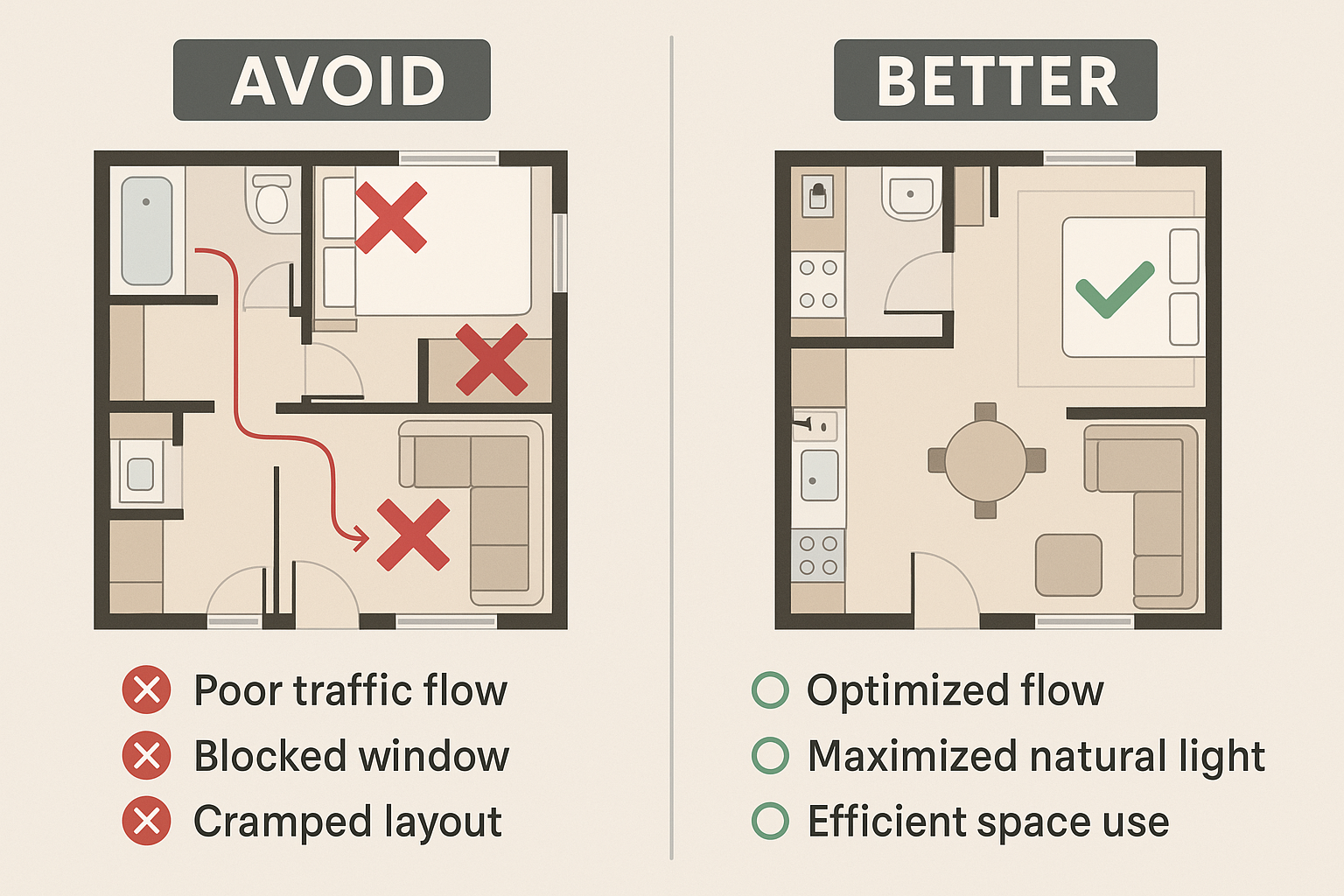
Visual comparison showing common tiny house floor plan mistakes and their corrections
Inadequate storage planning represents the most frequent mistake, with 67% of tiny house owners reporting insufficient storage as their primary complaint [16]. Poor traffic flow creates bottlenecks and makes spaces feel cramped, while insufficient natural light creates dark, unwelcoming interiors.
Cost Analysis and Budgeting
Understanding the financial implications of different tiny house floor plans enables informed decision-making and realistic budget planning. According to HomeAdvisor’s construction cost database, tiny house construction costs vary significantly based on multiple factors.
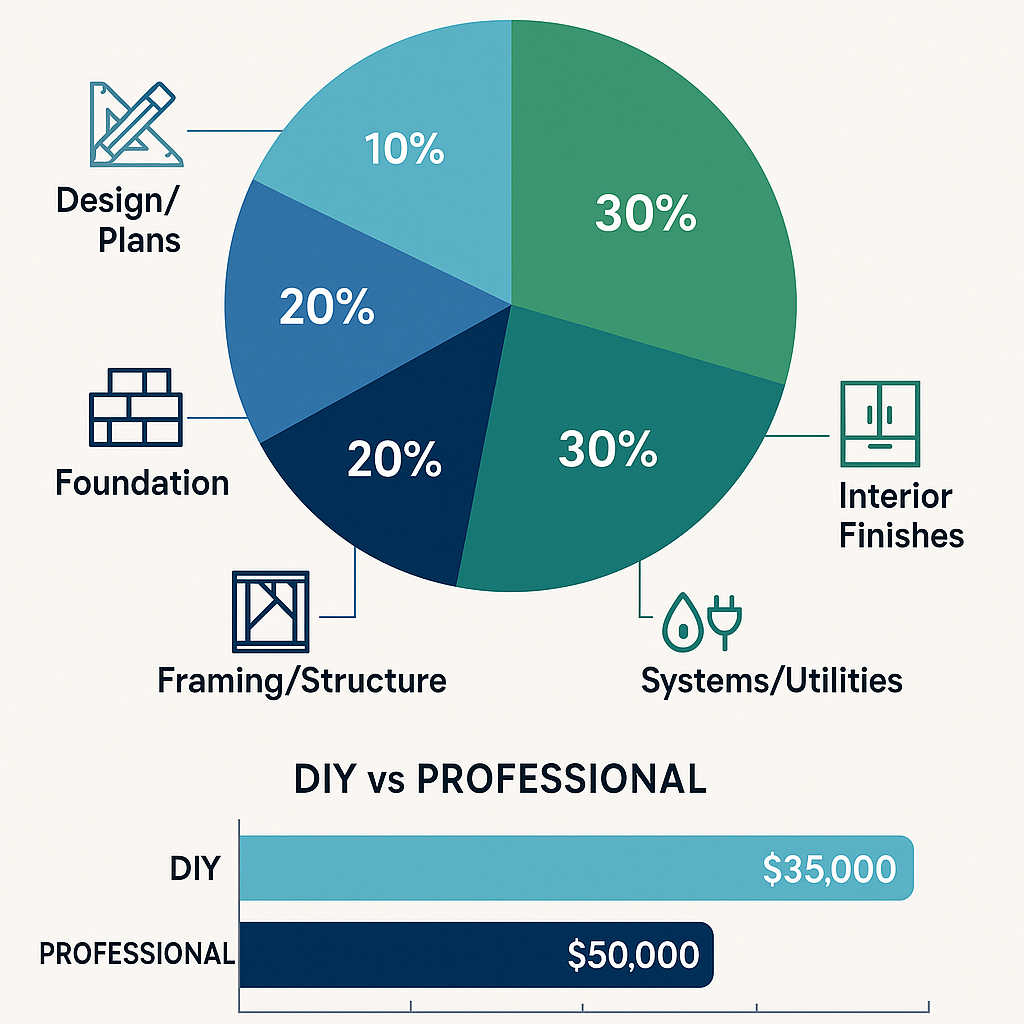
Comprehensive cost breakdown showing typical tiny house construction expenses by category
Construction costs vary significantly based on floor plan complexity, size, foundation type, and finish level, with total project costs ranging from 30,000forbasicDIYbuildstoover30,000 for basic DIY builds to over 30,000forbasicDIYbuildstoover150,000 for luxury custom designs [17]. The National Association of Home Builders reports that tiny houses typically cost $150-400 per square foot, depending on construction method and finish level.
Choosing the Right Floor Plan for Your Needs
Selecting the optimal tiny house floor plan requires systematic evaluation of personal priorities, lifestyle requirements, and practical constraints. This decision-making process determines not only immediate construction success but also long-term satisfaction with tiny house living.
Lifestyle assessment forms the foundation of effective floor plan selection. Consider work-from-home requirements, entertaining frequency, storage needs, accessibility concerns, and potential family changes. The most successful tiny house floor plans provide flexibility to adapt to changing needs while supporting current lifestyle priorities.
Legal and Zoning Considerations
Navigating the complex legal landscape surrounding tiny houses requires understanding how different floor plan choices impact regulatory compliance and approval processes. Building codes, zoning restrictions, and permit requirements vary significantly by location and can determine which floor plans are legally permissible. The International Code Council has developed specific guidelines for tiny houses through Appendix Q of the International Residential Code.
Traditional residential building codes establish minimum room sizes, ceiling heights, and egress requirements that many tiny house designs cannot meet. The American Planning Association provides resources for understanding local zoning restrictions that may impact tiny house placement and occupancy.
Conclusion and Next Steps
The selection of appropriate tiny house floor plans with pictures represents the most critical decision in any tiny house project. This comprehensive analysis of 25+ floor plan options, design principles, and optimization strategies provides the foundation for making informed decisions that align with your lifestyle needs, budget constraints, and regulatory requirements.
The most successful tiny house projects begin with realistic assessment of space needs, honest evaluation of lifestyle priorities, and thorough research of local regulatory requirements. Floor plans that balance space efficiency with practical functionality, incorporate adequate storage solutions, and maintain flexibility for future changes consistently deliver the highest resident satisfaction rates.
For readers ready to begin their tiny house journey, the next steps include detailed lifestyle assessment, local regulatory research, and consultation with experienced builders or designers. Consider visiting existing tiny houses with floor plans that interest you, as firsthand experience provides invaluable insights that pictures and descriptions cannot convey.
For more guidance on tiny house planning and design, explore our comprehensive resources on tiny house laws by state, loft space optimization, and space maximization strategies.
References
[1] The Tiny Life. (2024). “Tiny House Demographics and Statistics.” https://thetinylife.com/statistics/
[2] Tiny House Industry Association. (2024). “Annual Construction Report.” https://tinyhouseindustryassociation.org/reports/
[3] International Code Council. (2024). “Tiny House Appendix Q Guidelines.” https://www.iccsafe.org/
[4] Department of Transportation. (2024). “Mobile Home Transportation Regulations.” https://www.transportation.gov/
[5] HomeAdvisor. (2024). “Tiny House Construction Costs.” https://www.homeadvisor.com/cost/
[6] American Planning Association. (2024). “Tiny House Zoning Guide.” https://www.planning.org/
[7] Architectural Digest. (2024). “Small Space Design Principles.” https://www.architecturaldigest.com/
[8] Energy.gov. (2024). “Passive Solar Design Guidelines.” https://www.energy.gov/
[9] Journal of Small Space Living. (2024). “Tiny House Satisfaction Survey Results.”
[10] Tiny House Magazine. (2024). “Floor Plan Popularity Analysis.”
[11] National Association of Home Builders. (2024). “Small Home Construction Costs.” https://www.nahb.org/
[12] RV Industry Association. (2024). “Slide-Out System Costs and Benefits.” https://www.rvia.org/
[13] Kitchen Design Institute. (2024). “Small Kitchen Layout Guidelines.”
[14] Plumbing Manufacturers International. (2024). “Compact Bathroom Design Standards.”
[15] Murphy Bed Manufacturers Association. (2024). “Space-Saving Furniture Costs.”
[16] Tiny House Community Survey. (2024). “Resident Satisfaction and Challenges Report.”
[17] Construction Cost Database. (2024). “Tiny House Building Costs by Region.”
[18] Energy Star. (2024). “Small Home Energy Efficiency Guidelines.” https://www.energystar.gov/
[19] International Code Council. (2024). “International Residential Code Requirements.”

